For an informative article on Egyptian temples including a long list of links to information on individual temples, see http://www.touregypt.net/featurestories/temples.htm
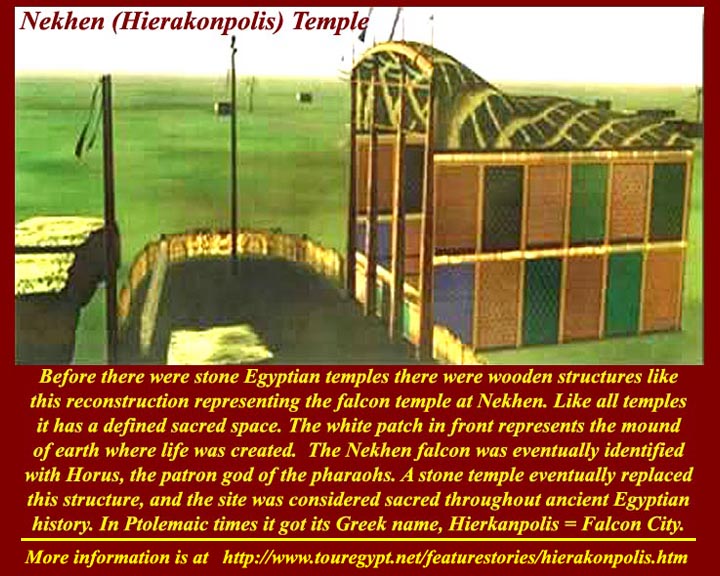
http://www.mmdtkw.org/EGtkw0401NehkenWoodTemple.jpg
The Egyptians believed that creation took place on a rocky mound or outcrop near the Nile River. Their earliest sacred spaces may simply have been rocky outcrops that stood above the annual inundations. When more formal stuctures were built, they often had a ceremonial representaton of the outcrop, like the white area in front of the Nekhen reconstruction drawing. Structures such as this one probably would not have been the first "temples" of the ancient Egyptians, but, until now, they are the first to leave enough traces to allow for reconstruction drawings. Earlier areas thought perhaps to be the remains of religious sites (circles of stones) are ambiguous. And the earliest settlements along the Nile -- temples and all -- are undoubtedly buried under yards/meters of silt close to the River. Only when sacred spaces were sited on higher ground farther from the river have their traces been found. Early art work, along with post holes, etc., assist in reconstructions.
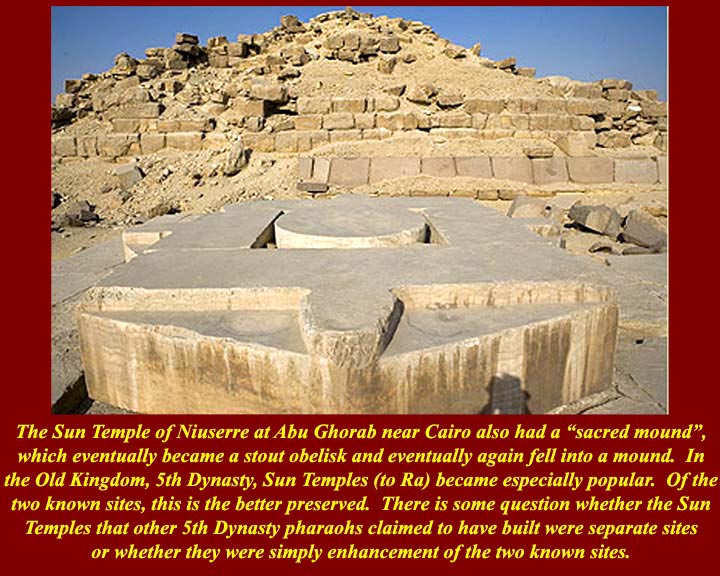
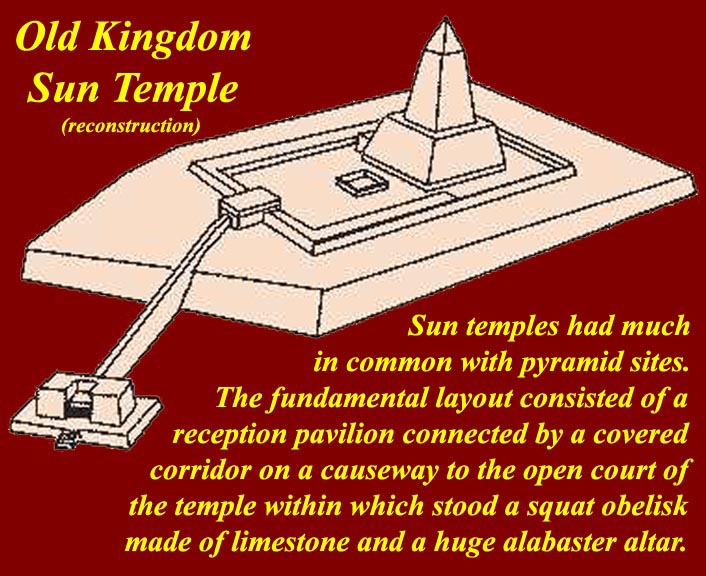
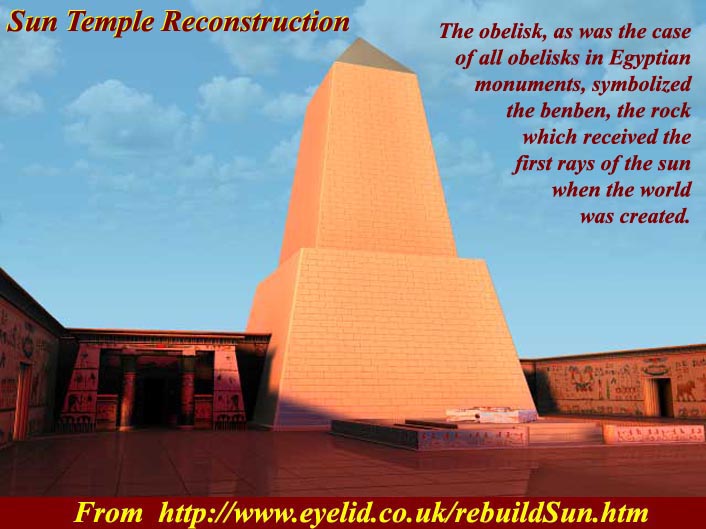 http://www.mmdtkw.org/EGtkw0402NiuserreSunTemple1.jpg
http://www.mmdtkw.org/EGtkw0402NiuserreSunTemple1.jpghttp://www.mmdtkw.org/EGtkw0403aNiuserreSunTemple2.jpg
http://www.mmdtkw.org/EGtkw0403bNiuserreSunTemple3.jpg
Niuserre (meaning "Possessed of Re's Power"), the 5th pharaoh of the 5th dynasty built his Sun temple at modern abu Ghorab about one kilometer north of his pyramid complex at Abusir. He is of the dynasty that followed the Great Pyramid builders, and his Solar temple is built on a similar plan to the pyramids -- a squat obelisk replaces the pyramid, but there is a "valley temple" (at the high water mark of the inundation) and a causeway that vent up to the temple compound. The obelisk is, once again, representative of that rocky mound or outcrop where the first rays of the sun struck the Earth and where life was created. The reconstruction is conjectural, the obelisk height being based on its collapsed debris and the strength of its foundation. For more on Niuserre and his monuments, see http://www.crystalinks.com/pyrniuserre.html and http://www.touregypt.net/featurestories/niuserre.htm.
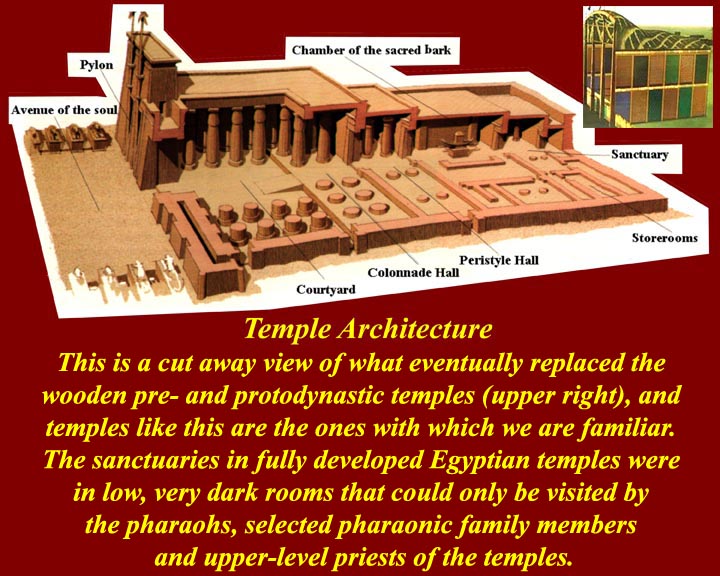
http://www.mmdtkw.org/EGtkw0404StoneTempleArchitecture.jpg
Stone temples were built on the pattern of the earlier wood temples and probably on the pattern of mud-brick temples. The sites stayed the same and generations of temples replaced previous temples sequentially. As more rites were added, more rooms were needed so they strung out. The newer rooms were always larger and added at the front of the existing temples until they got too long for the space available. Really big complexes, like Karnak, then sprouted additional axes, usually perpendicular to the original axis. The Luxor temple complex has a slight dogleg because the front end eventually got too close to the Nile.
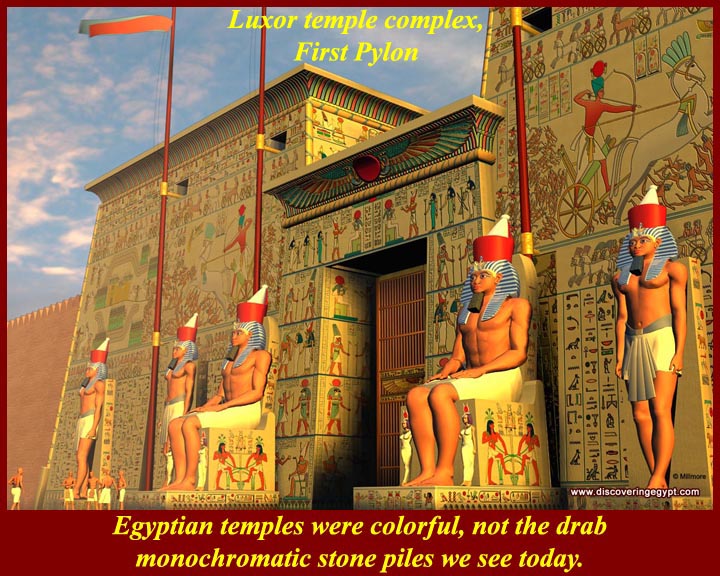
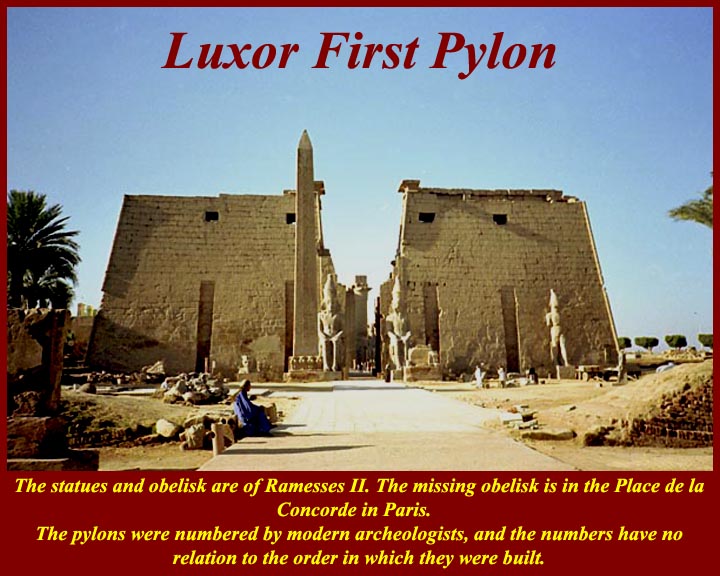
http://www.mmdtkw.org/EGtkw0405LuxorTemple2-1.jpg
http://www.mmdtkw.org/EGtkw0406LuxorFirstPylon.jpg
What we see today is a pale shadow of how the temples looked when they were new. The reconstruction of the "First Pylon" of the Luxor temple complex shows how they really might have looked. The numbering of the Pylons at the big temples is a modern locational convention. Pylons are really giant flat towers at the side of the gates, and they served ad billboards for the donor pharaoh. The "first pylon" is the one that's nearest to the front of the complex, and it is often the last one that was built. Then they are numbered toward the innermost sanctuary, which was often the first room that was built. At Karnak, the pylons off to the side are numbered after those going from front to back. For more on Egyptian stone temple architecture, see http://www.ancientegypt.co.uk/temples/home.html and http://www.touregypt.net/featurestories/temples.htm.
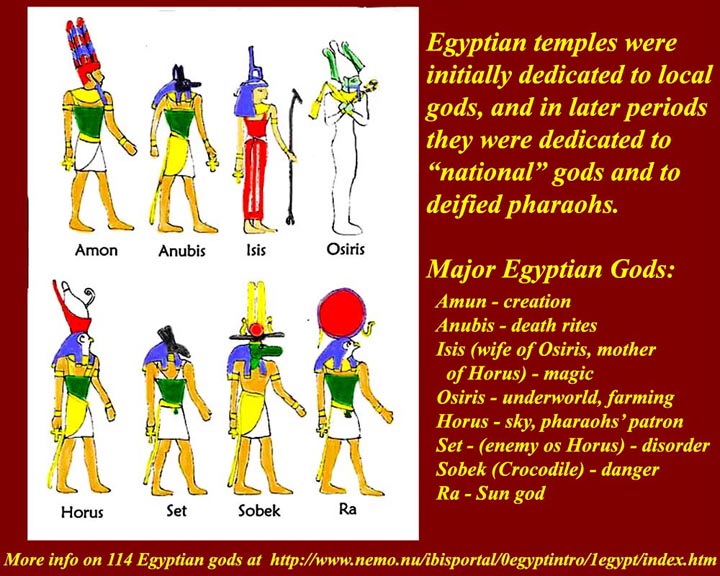
http://www.mmdtkw.org/EGtkw0407EgyptGods.jpg
The Egyptians collected gods. Village gods -- from all villages -- became national gods or aspects of national gods. They saw spirits in every part of every plant, animal, rock, or celestial body and called them all gods. 19th and 20th century attempts to bring order to the Egyptian pantheon and to establish one primary creator or supreme being are at odds with what the ancient Egyptians apparently believed. At least 2000 separate entities have been counted by modern enumerators, but it is doubtful that any ancient Egyptian knew them all by name or by attributes: gods were "invented" and invoked when and as needed. The single known ancient Egyptian attempt at monotheism -- Akhenaten during the "Amarna Period" -- was more political and opportunistic than theological. Akhenaten wanted to be, and, in Amarna at least, was, for a short time, the sole conduit to the only god. But that was quickly rejected when he died, and his heir, Tutankhaten, quickly changed his name to Tutankhamun reflecting his rejection of Akhenaten's supreme god, Aten, and a return to the previous multi-theistic system and especially to the Theban god Amun. One of many Internet sites that illustrates and expounds upon the more important ancient Egyptian gods and goddesses is at http://www.ancientegypt.co.uk/gods/explore/main.html. Another is at http://www.nemo.nu/ibisportal/0egyptintro/1egypt/index.htm.
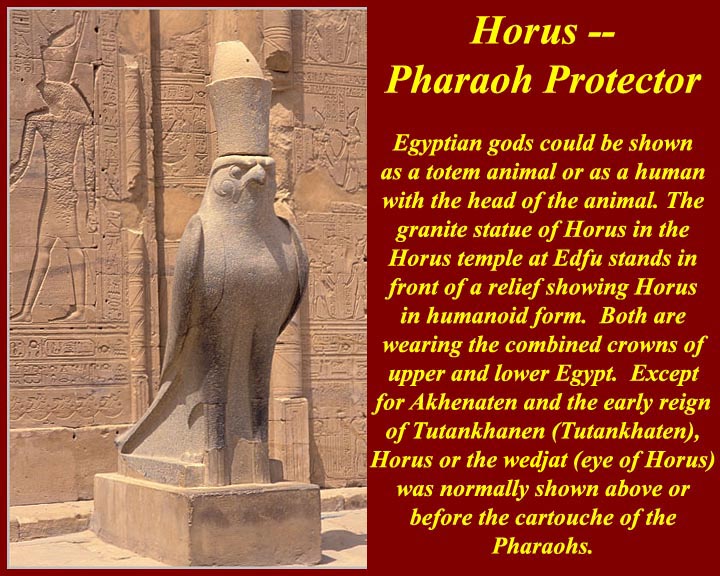
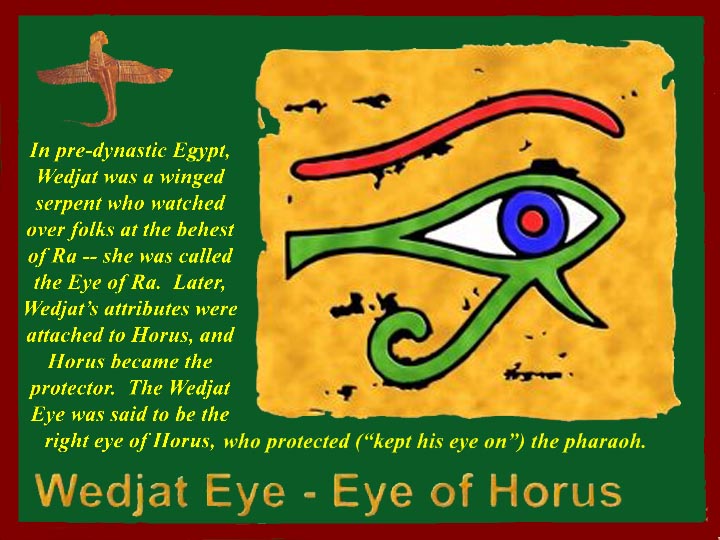
http://www.mmdtkw.org/EGtkw0408HorusEdfu.jpg
http://www.mmdtkw.org/EGtkw0409HorusWedjat.jpg
Horus is one of the most ancient gods of the Ancient Egyptian religion, who appears in his earliest form in late Pre-dynastic Egypt. Represented as a falcon, his name is believed to mean 'the high' or 'the far off' and his earliest connections are to the sky and kingship. Because the cult of Horus survived for the whole of the Ancient Egyptian civilization he gained many forms and associations. Horus was usually represented as a man with a falcon's head. One important association is the Eye of Horus which was an Egyptian symbol of kingship and power and of the offerings made to the god Osiris and by extension to all the dead. In one myth cycle Horus' left eye is injured during his struggle with his uncle Set, who had murdered Osiris in an attempt to seize the Egyptian throne. The Eye of Horus, its injury and subsequent restoration became an important symbol for the unified land of Egypt and in the funerary rites of the renewal after death. In other legends the eye, or wedjat was originally a winged serpent who guarded from "on high". Already in pre-dynastic times the eye of the serpent is identified with the all-seeing eye of Horus (right or left, depending on who's telling the story).
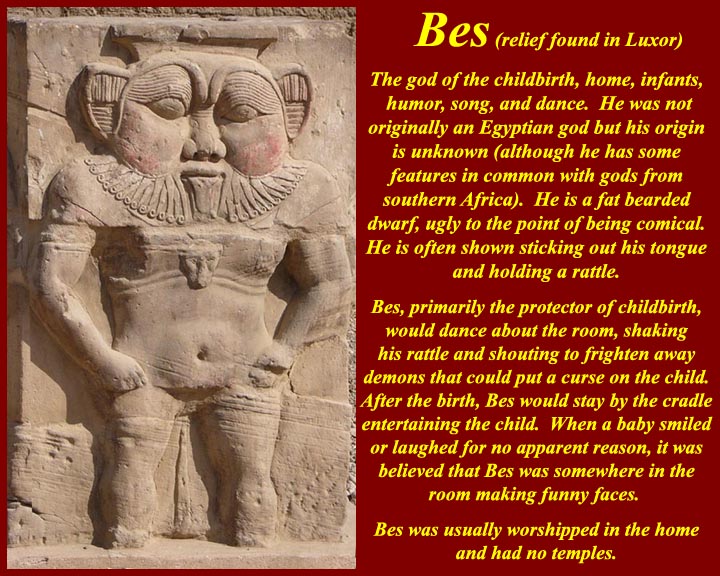
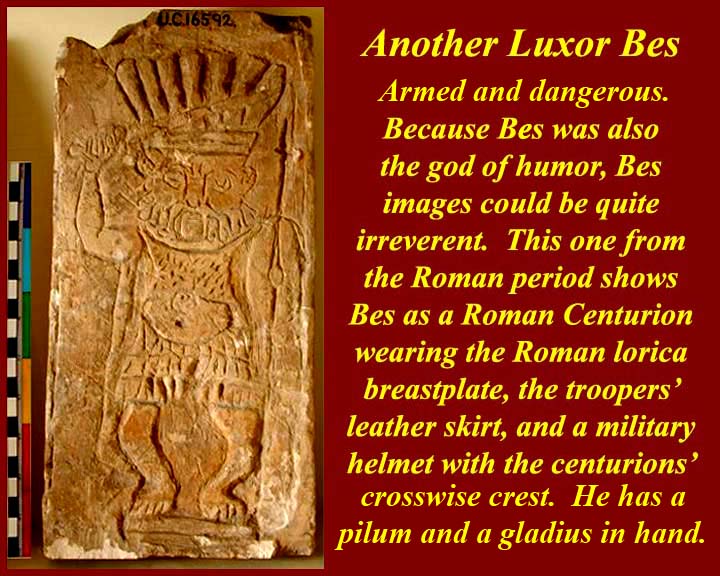
http://www.mmdtkw.org/EGtkw0411BesLuxorRelief.jpg
http://www.mmdtkw.org/EGtkw0412RomanSoldierBes.jpg
Bes is unlike the run of Egyptian gods and is probably an import, perhaps from sub-Saharan Africa. He is the jokester and is particularly loved by parents, because he keeps kids healthy and happy. Irreverence is his stock and trade (as seen in the second image, from the Roman period, where he is stocky Roman Centurion. He is often associated with Hathor, the goddess of motherhood and childbirth. Mothers wanted Bes to show up at the birth to chase away malignant demons and enemy gods.
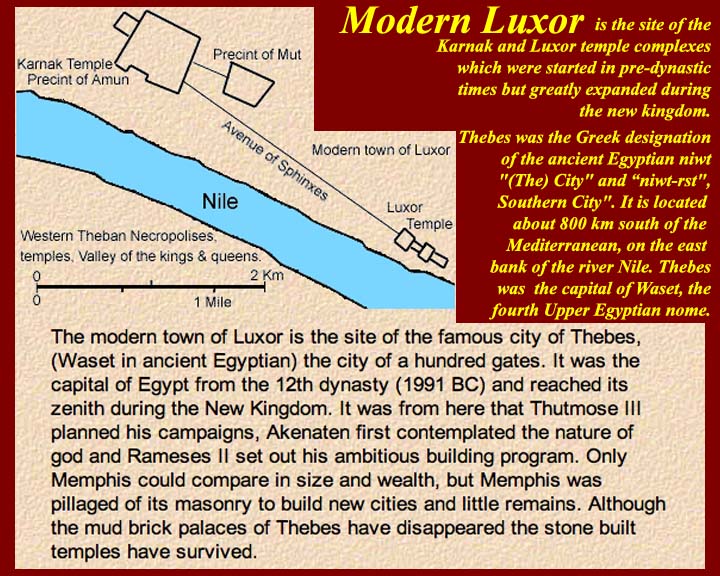
http://www.mmdtkw.org/EGtkw0413LuxorThebesMap.jpg
Both the Karnak and Luxor temple complexes are now in Luxor city, but in ancient times they were on the northern outskirts of Thebes. In the early days of the two complexes, they were connected by a canal that was later paved over and lined with sphinxes to make the "avenue of sphinxes. Pilgrims, who earlier had progressed by boat, then had to go afoot.
Modern Luxor, ancient Thebes, is on the Big Bend of the Nile River in central Egypt. The name Luxor is from Arabic al-Uksur (= probably, the palaces, singular is Qasr) and Karnak is also Arabic , al-Karnak (perhaps from qarnak = "his horn"? -- Alexander was "the Two Horned"). Neither name has anything to do with the ancient names of the city: nwt = "the city"; wst = name of the 4th nome of upper Egypt (from which, perhaps, the modern Arabic word Waset = middle); or Thebes (= likely a Hellenization of ancient Egyptian t'ipt-swt -- lit. "The name Waset" -- both of which refer to the same place, though it is not called Thebes until the Greek invasion. The official Greek (Ptolemaic) name was Diospolis Megale = city of Zeus (because Dios = Zeus) the Great, and the Romans called it Diospolis Magna with the same meaning as the Greek name.
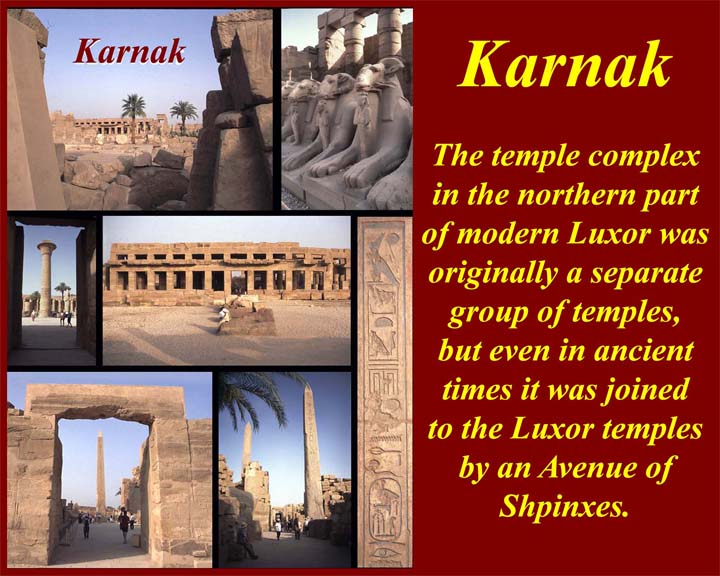
http://www.mmdtkw.org/EGtkw0414Karnak1.jpg
Karnak was on the northern outskirts of Thebes and must originally have been a cult center on its own. Very early on, however, the Karnak and Luxor temple complexes developed integrated observances -- at least to the point of the gods visiting each other on their "sacred ships." A long "avenue of sphinxes" joined the two cities, but the big events involved boats and barges that could pull up to the forecourts of both temple complexes. On some occasions the convoy of boats also docked at temple platforms on the far (western) side of the river in a kind of grand tour of the sacred vessels (which, eventually were small "models" that could be carried right into the temples to be placed sequentially on special pedestals in front of the temple sanctuaries.
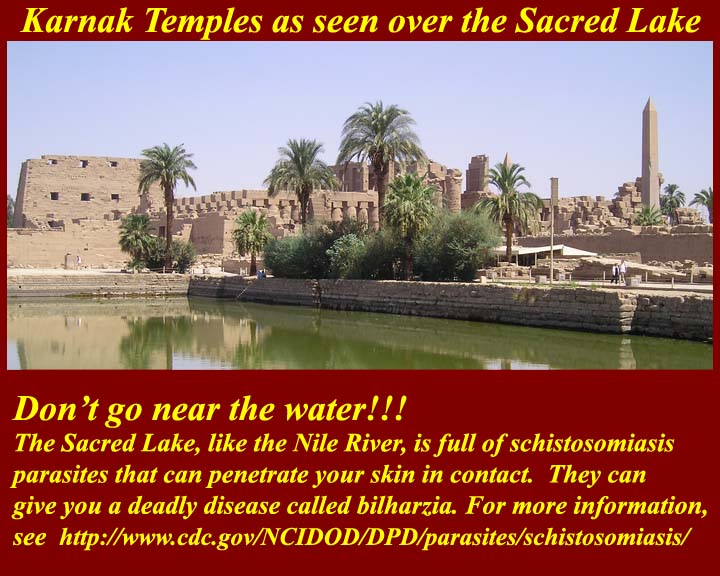
http://www.mmdtkw.org/EGtkw0415KarnakTemple.jpg
Off to one side of the Karnak complex is the Sacred Lake, a kind of huge
"holy water" pool, across which you can now sit after dark to see one of Egypt's famous "sound and light" show. As the note on the image states, it's thoroughly contaminated with schistosomiasis parasites which can give you the debilitating and eventually fatal disease bilharzia. The Nile is also loaded with the critters, especially in the shallows where their snail vectors dump them by the millions. You don't want this disease, so stay out of and don't drink Nile water. Guides might tell you that water from the center of the River is safe, but don't believe it.
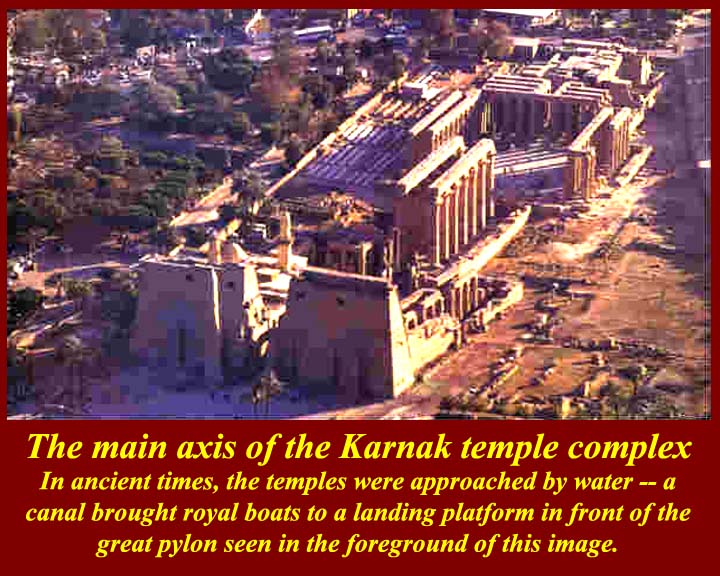
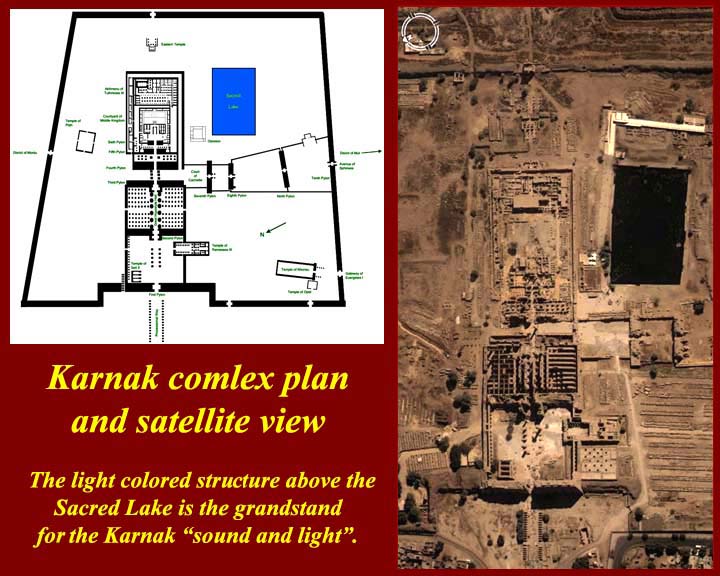
http://www.mmdtkw.org/EGtkw0416Karnak2.jpg
http://www.mmdtkw.org/EGtkw0417KarnakPlanSatellite.jpg
In these images it's fairly easy to see the general progression of construction of the Karnak temple complex. The parts that are farthest away were built first and the closest part brought construction about as far as it could come toward the Nile. Then the new axis was added toward the southeast.
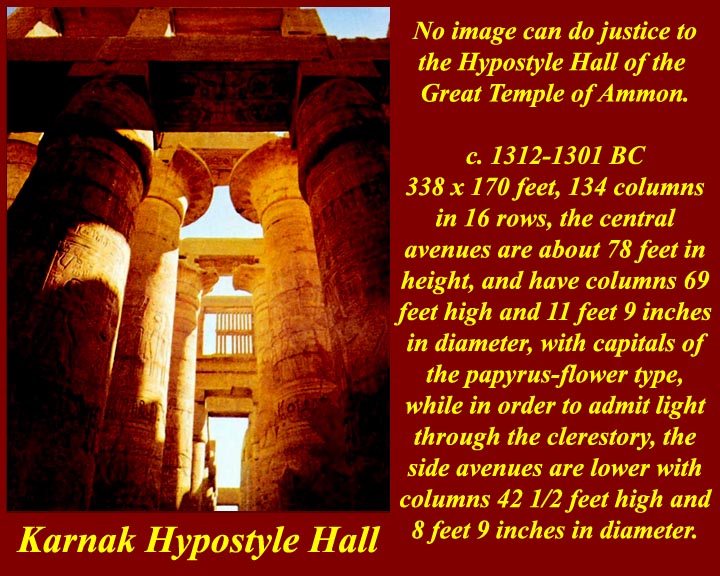
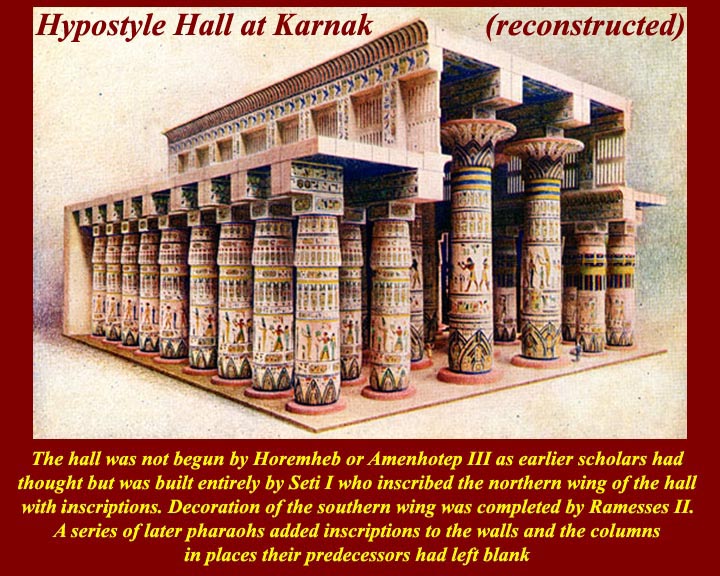
http://www.mmdtkw.org/EGtkw0418HypostyleKarnak.jpg
http://www.mmdtkw.org/EGtkw0419KarnakHypostyle.jpg
The famous Hypostyle (= "many pillared") Hall of Karnak was designed to be flooded during the annual inundation. At those times, the 134 massive columns would rise from the water like the stems of open and closed papyrus stalks after which they are modeled. They are said to have represented the papyrus swamp on the edge of that rocky outcrop on the bank of the Nile where creation took place. For much more information on the Hypostyle hall, visit The Karnak Great Hypostyle Hall Project of the University of Memphis, Tennessee, at http://history.memphis.edu/hypostyle/.
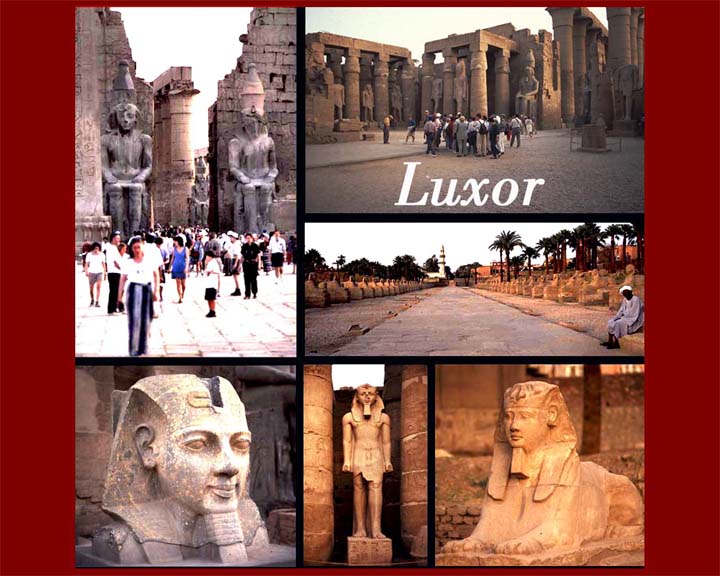
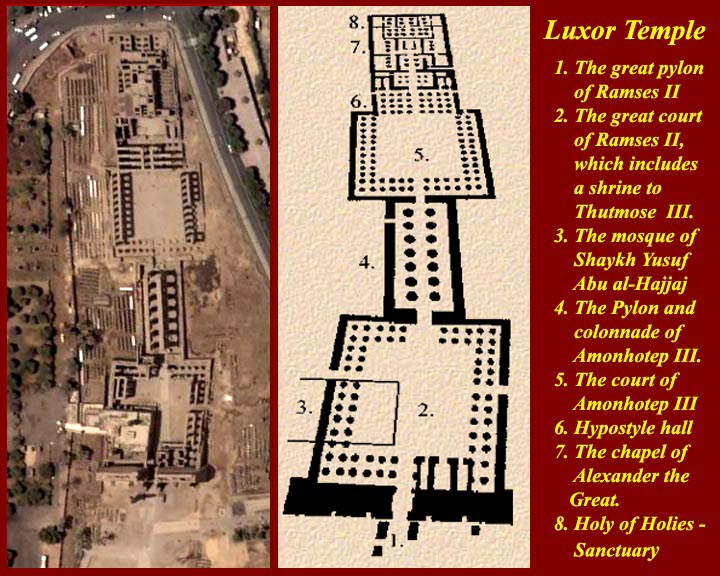
http://www.mmdtkw.org/EGtkw0420LuxorTemples.jpg
http://www.mmdtkw.org/EGtkw0421LuxorTemplePlan.jpg
The Luxor temple complex is built on a single (slightly dogleg) axis that is roughly parallel to the Nile. Its ship landing platform was connected to the river by a short inlet in ancient times. In front of the first pylon, that of Ramesses II is a short avenue of sphinxes. The avenue was originally much longer, but it was truncated when Ramesses built his (dogleg) courtyard and pylon in front of what was already there. Most of the sphinxes are now along one wall of the courtyard, still waiting, after many centuries, to be moved to their new intended location. The big Ramesses II project was never finished: his Pylons are undecorated; a construction ramp remains against one inner wall of the courtyard; and the inner walls of the courtyard have big blank spaces waiting for vignettes and hieroglyphs. Like our remodeling projects, the contractor probably had more than one job going.
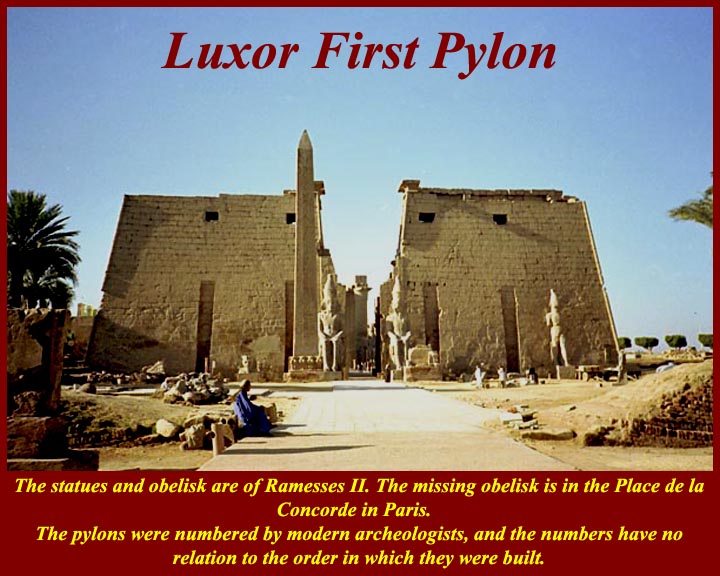
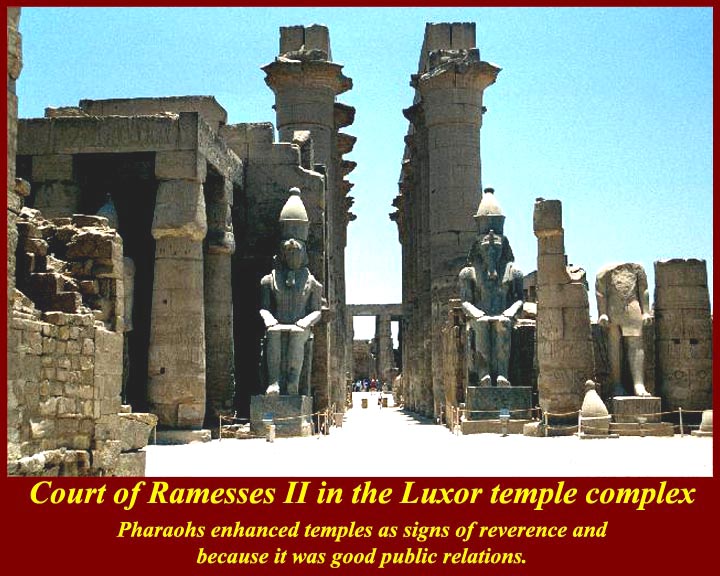
http://www.mmdtkw.org/EGtkw0422LuxorFirstPylon.jpg
http://www.mmdtkw.org/EGtkw0423LuxorCourtRamesses.jpg
Part of the problem that Ramesses had was that he went for size rather than quality. Another problem is that he wanted a big new temple wherever there was an existing small old temple. He had to many temples under construction and too many other project even for his reputed 66 year reign. His monuments are of impressive size, but the quality is lacking, even in sculptures of himself.
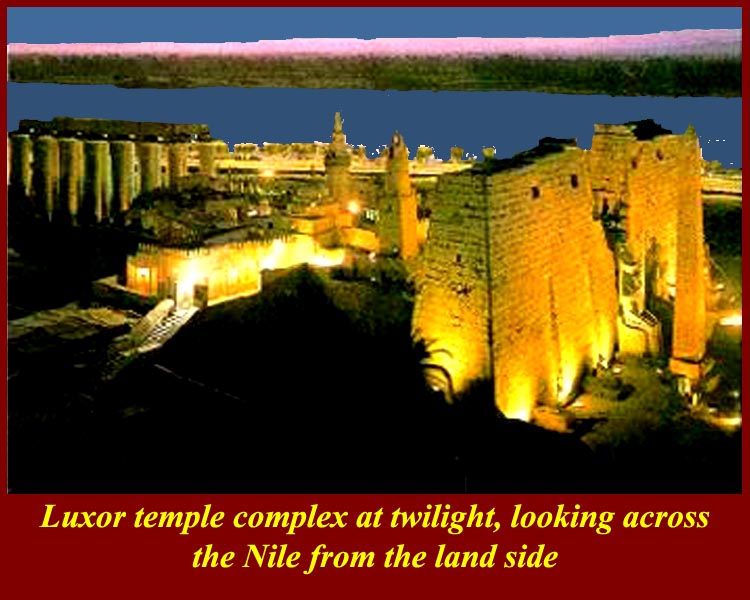
http://www.mmdtkw.org/EGtkw0424LuxorTwilight.jpg
Luxor from the land side in morning twilight. On the other side of the temple complex is the Nile, then the cultivated area on the other (western) side of the Nile, and, on the far horizon, the Theban Hills with the Valleys of the Kings, Queens, and Nobles catching the morning sunrise. One of the things you can do in Luxor, if you are an early riser, is to take a 45 minute hot air balloon ride (about $85 US). Bring your camera for pix like this.
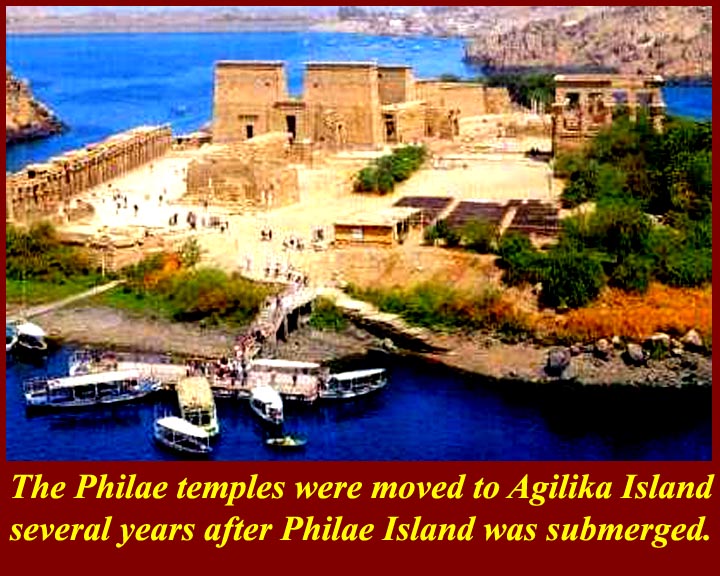
http://www.mmdtkw.org/EGtkw0425PhilaeAgilika.jpg
The Philae temples are no longer on Philae. They were moved to Agilika Island to raise them above the flood level of the Old Aswan Dam. The island was sometimes visible and sometimes not after the Old Aswan Dam was built, but was permanently submerged after the newer Aswan High Dam ensured that the downstream lake was always full. If that's confusing, see the map at http://www.touregypt.net/featurestories/philae5-1.jpg.
A five part article on Philae begins at http://www.touregypt.net/featurestories/philae.htm.
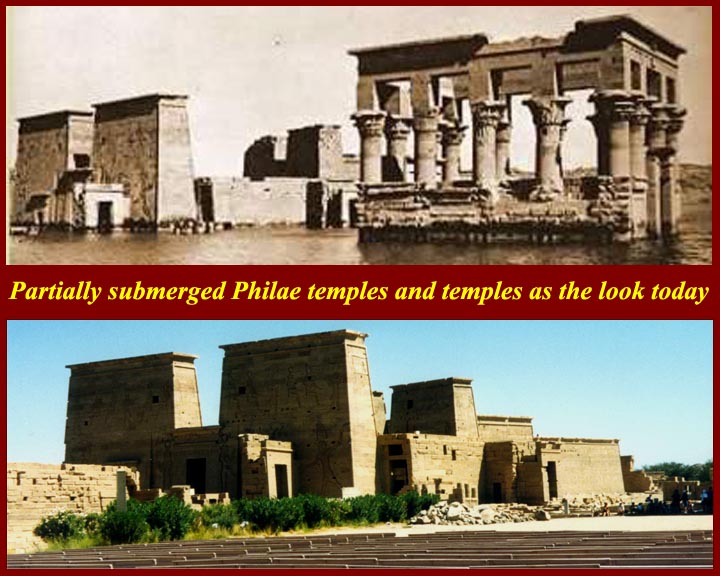
http://www.mmdtkw.org/EGtkw0426PhilaeSubmerged.jpg
Philae temples partially submerged at their old location and as they are now at their new location on the nearby Agilika Island
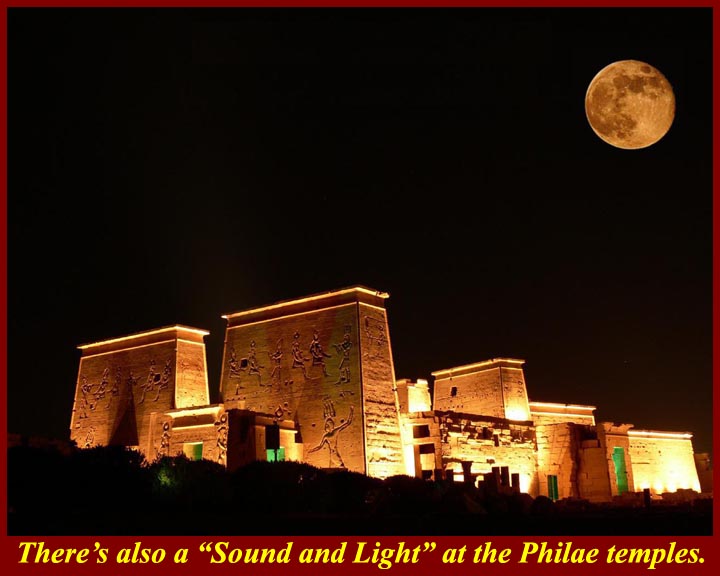
http://www.mmdtkw.org/EGtkw0427PhilaeNight.jpg
Yes, there is another of those great Sound and Light Shows at the Philae temples.
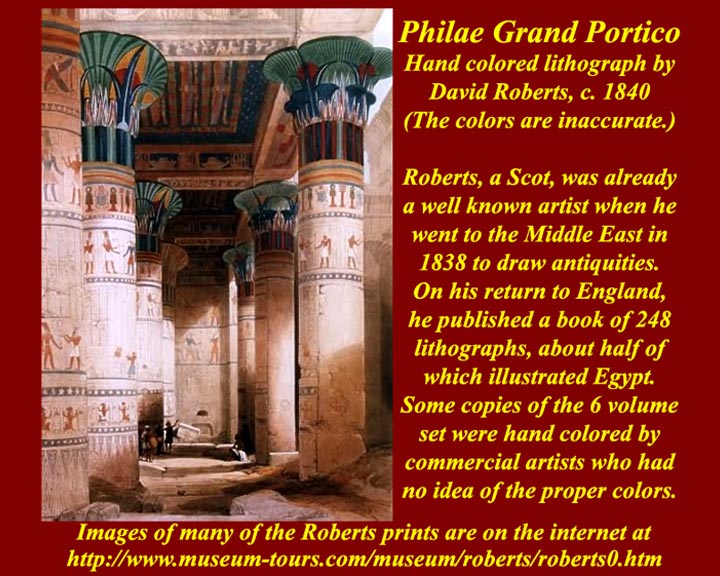
http://www.mmdtkw.org/EGtkw0428RobertsPhilae.jpg
The image shows a hand colored David Roberts lithograph of the pillars inside the main Philae Temple of Isis. Roberts was a Scot who traveled in Egypt in the 1840s. His drawings were published in London in folio and quarto volumes in the 1850s. Desirable full folio images (i.e., single images that covered a folio page) now cost $4000 - 5000. Half folios can cost $1000. Less desirable prints can be had for less. Modern offprints are available at all the appropriate Egyptian sites for a few dollars.
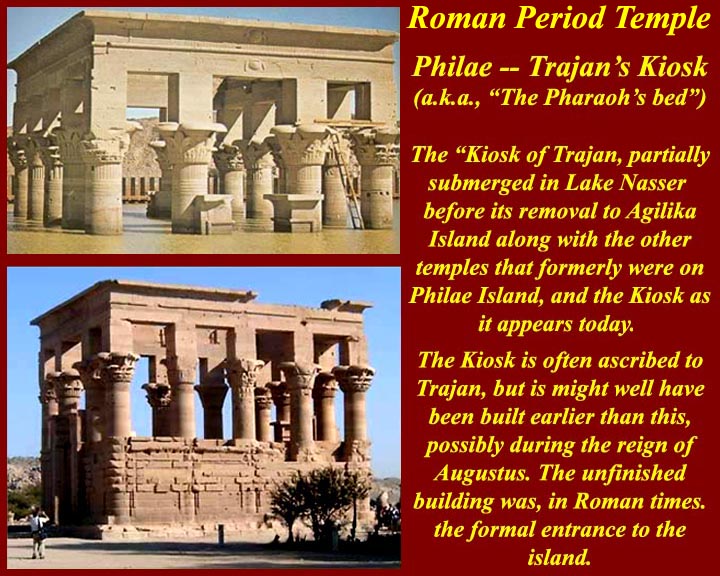
http://www.mmdtkw.org/EGtkw0429RomanPhilae.jpg
The Philae Roman period "Trajan's Kiosk" is much more romantic half submerged.
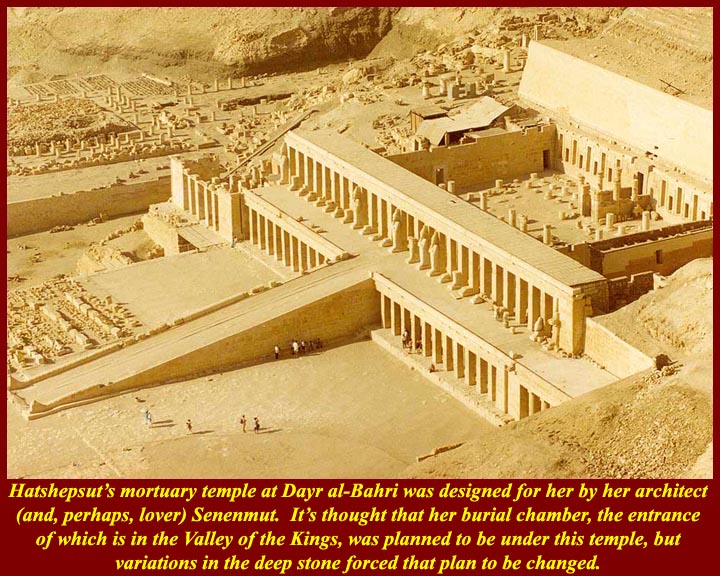
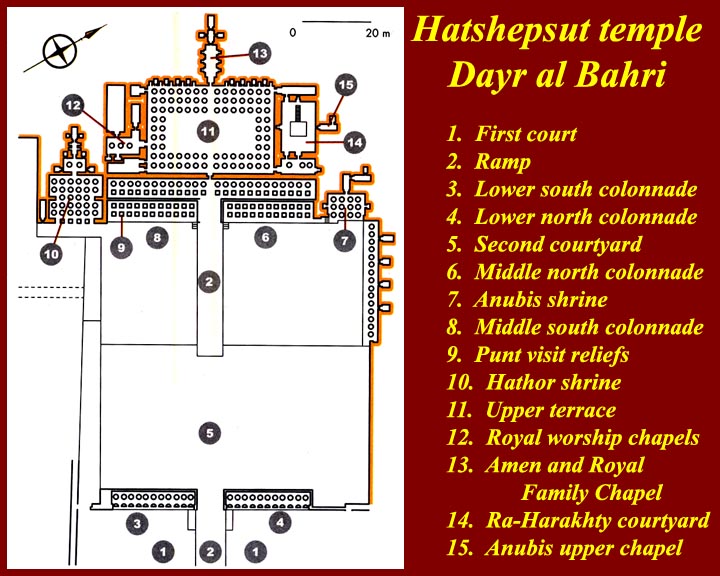
http://www.mmdtkw.org/EGtkw0430hatshetsupTemple.jpg
http://www.mmdtkw.org/EGtkw0431HatshepsutTemplePlan.jpg
Hatshepsut's mortuary temple complex at Dayr al-Bahri, across the river from Luxor was intended to stand directly over her tomb, the entrance of which is directly behind the temple, in the Valley of the Kings. Her plan went awry when the tomb tunnel, the deepest and longest in the Valley of the Kings, hit a level of unstable rock and had to be curved around itself in a very broad horseshoe. The tunnel never did pass under the ridge. For more on her Temple, see the second half of the article on Dayr al-Bahri at http://www.touregypt.net/featurestories/bahri.htm. For more on her tomb see http://www.touregypt.net/featurestories/kv20.htm.
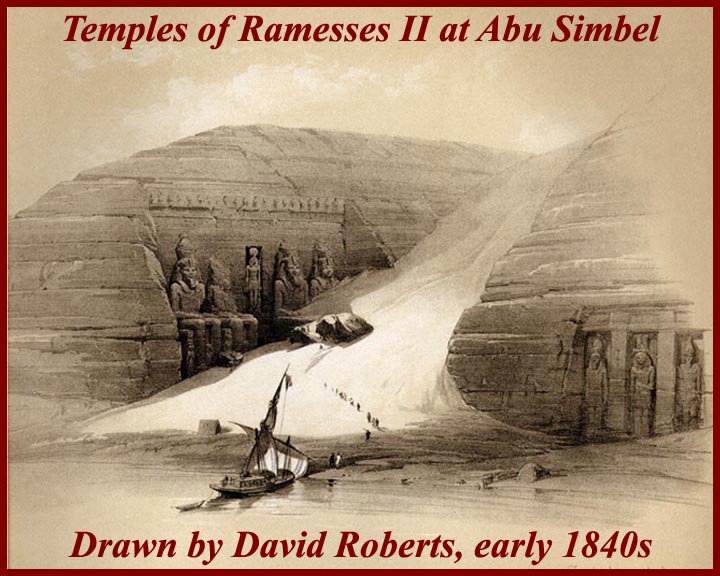
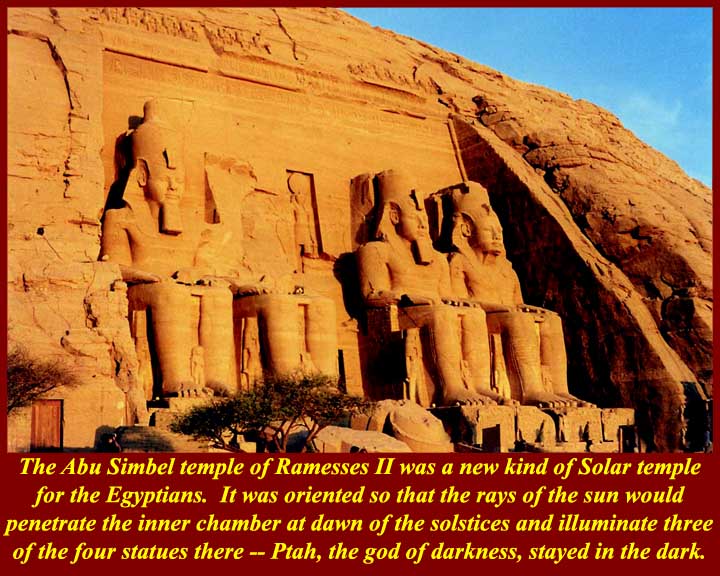
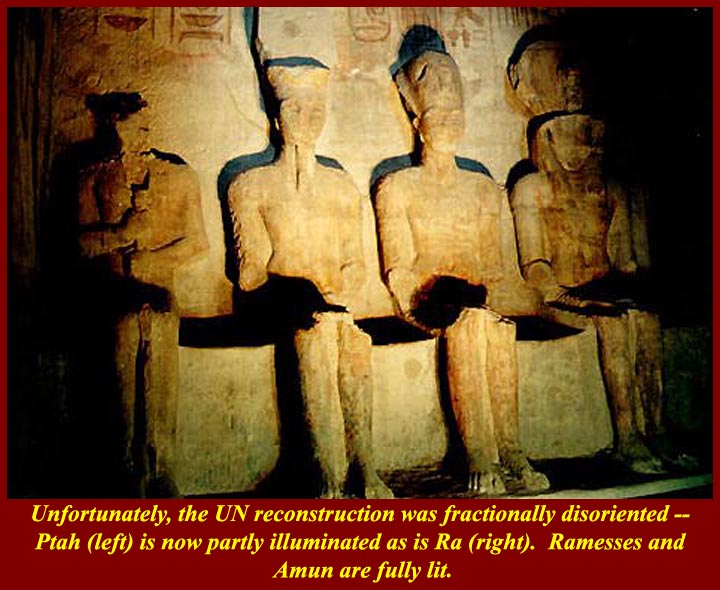
http://www.mmdtkw.org/EGtkw0432AbuSimbelRoberts.jpg
http://www.mmdtkw.org/EGtkw0433AbuSimbel.jpg
http://www.mmdtkw.org/EGtkw0434AbuSimbelShrine.jpg
The first (David Roberts) image shows the Abu Simbel temple as it must have looked when Belzoni started to excavate the site. By the 1840s, it's impossible to see any effect of Belzoni's dig around the front entrance in 1814. Ramesses II dedicated this temple to Ptah, Amun, Ra, and, of course, to Ramesses II. In the interior, where cult statues usually sat, Ramesses placed a statue of himself between the creator and solar gods, Amun and Ra, with Ptah on the other side of Amun. The Abu Simbel temple was a new kind of Solar temple for the Egyptians: dawn solstice light was penetrated the temple and illuminated Amun, Ra, and Ramesses (and left Ptah, the god of darkness, in the dark). This kind of temple was "Asian", that is, in Egyptian terms, from the countries on the eastern shore of the Mediterranean. The Jewish temple in Jerusalem had this kind of Solar aspect (although the Jewish god was a god of lightning and thunder, like Zeus). In the sequel, the UN project to save the Abu Simbel temple from the rising waters of Lake Nasser was off by a fraction of a degree and the lighting trick doesn't quite work in the new location.
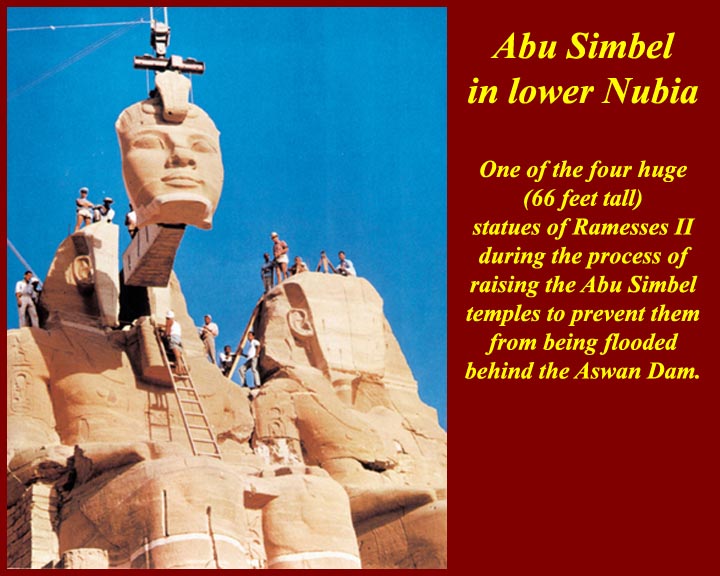
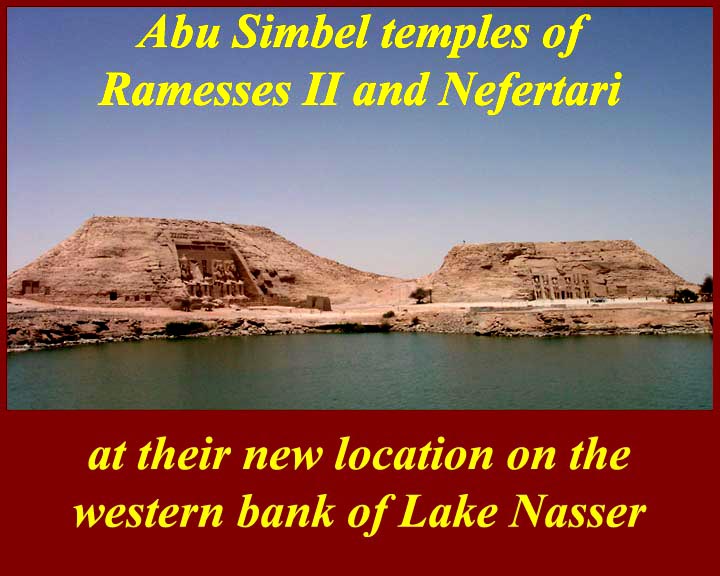
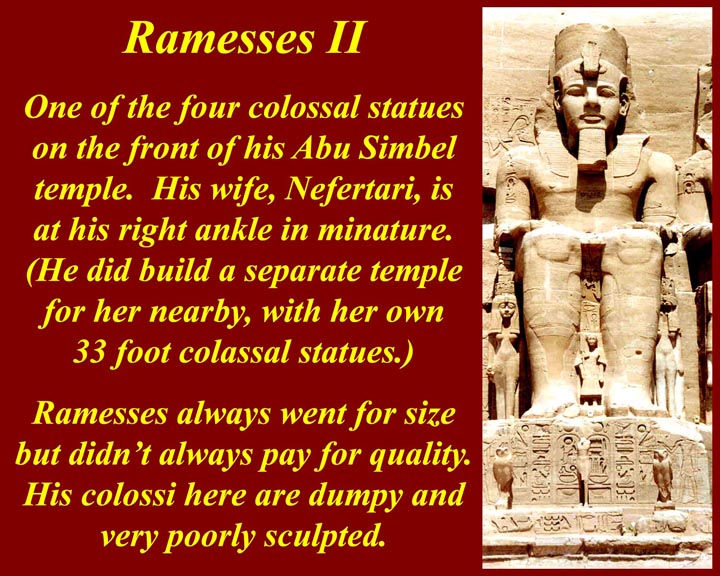
http://www.mmdtkw.org/EGtkw0435AbuSimbel2.jpg
http://www.mmdtkw.org/EGtkw0437AbuSimbelWesternBank.jpg
http://www.mmdtkw.org/EGtkw0436AbuSimbelRamessesII.jpg
Even though the reassembly was a bit askew, it was still an amazing engineering feat. The new location did nothing to improve the crudity of the colossal sculptures of Ramesses II, which looked a lot better when the legs were buried.
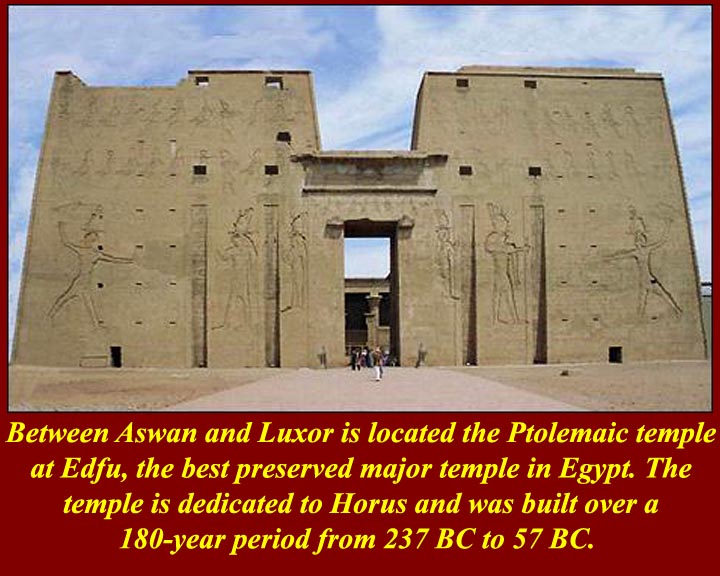
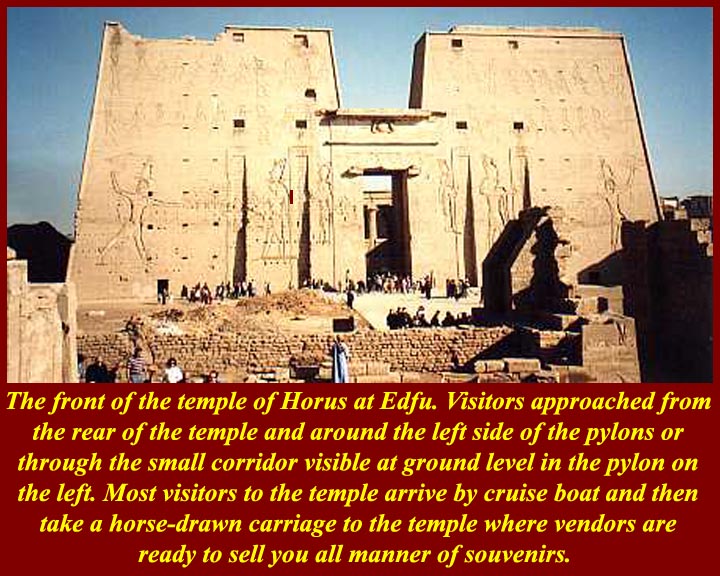
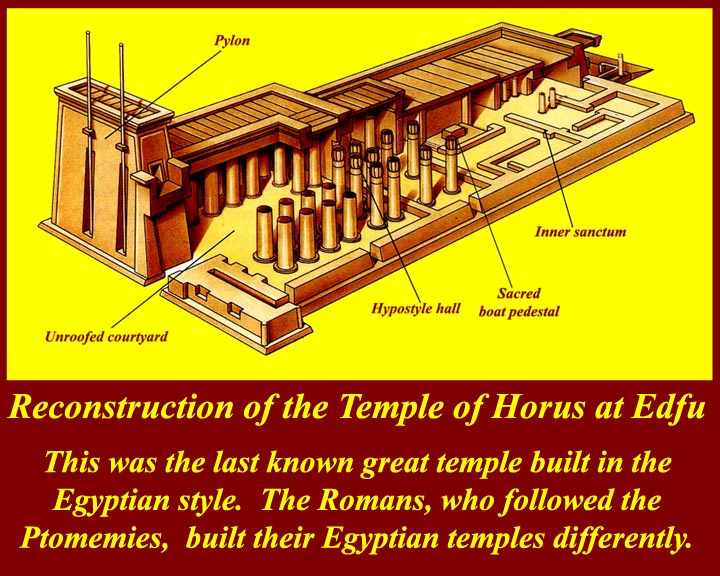
http://www.mmdtkw.org/EGtkw0438Edfu.jpg
http://www.mmdtkw.org/EGtkw0439EdfuEarly.jpg
http://www.mmdtkw.org/EGtkw0440HorusTempleEdfu.jpg
The best preserved ancient Egyptian temple is at Edfu and was built during the Ptolemaic period. Dedicated to Horus, it's also the last really big temple (that we know of) in this style. Later temples and later remodeling jobs on existing temples were in a hybrid Roman and Egyptian style.
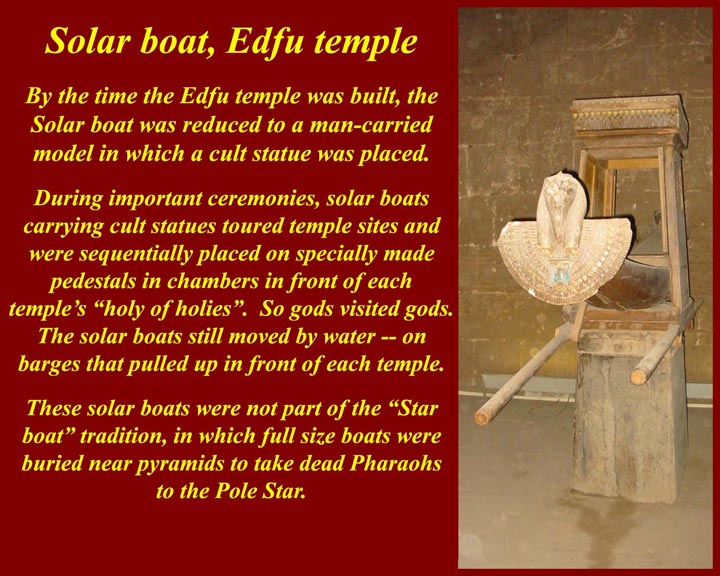
http://www.mmdtkw.org/EGtkw0441SolarBoatEdfu.jpg
The heavily reconstructed Edfu solar boat. A cult statue would ride to visit gods in other temples. These boats were not meant to be floated, but rather they would be carried by priests from a pedestal on a barge to a pedestal in the temple.
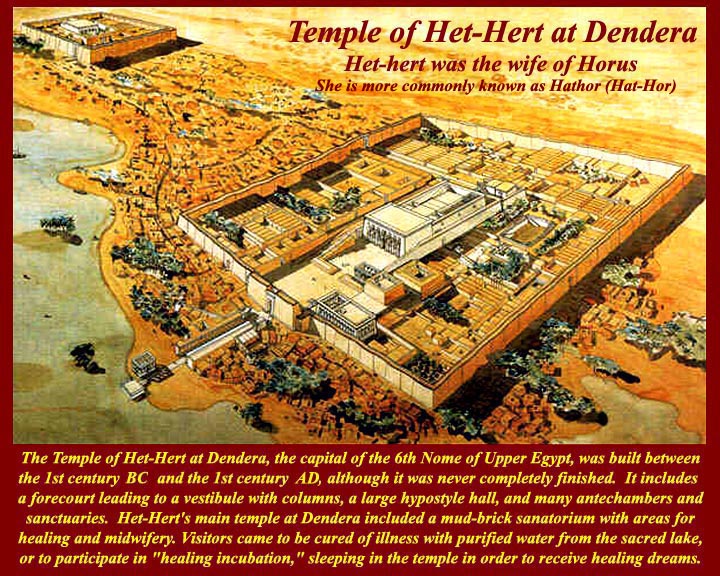
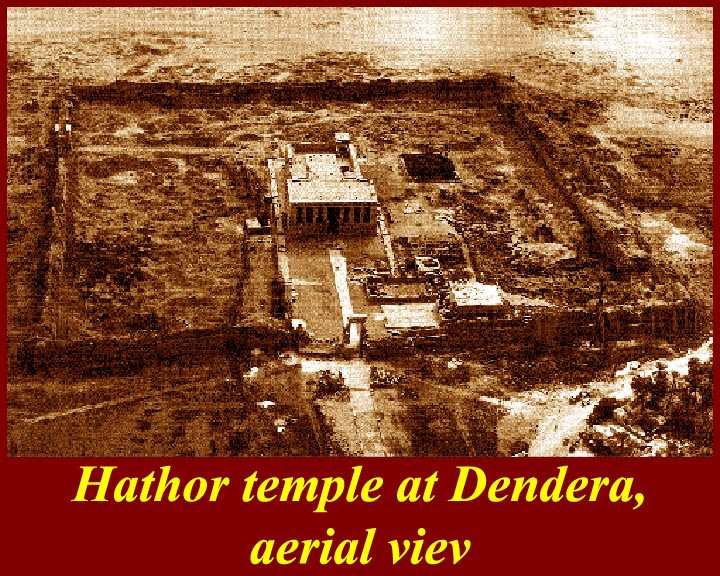
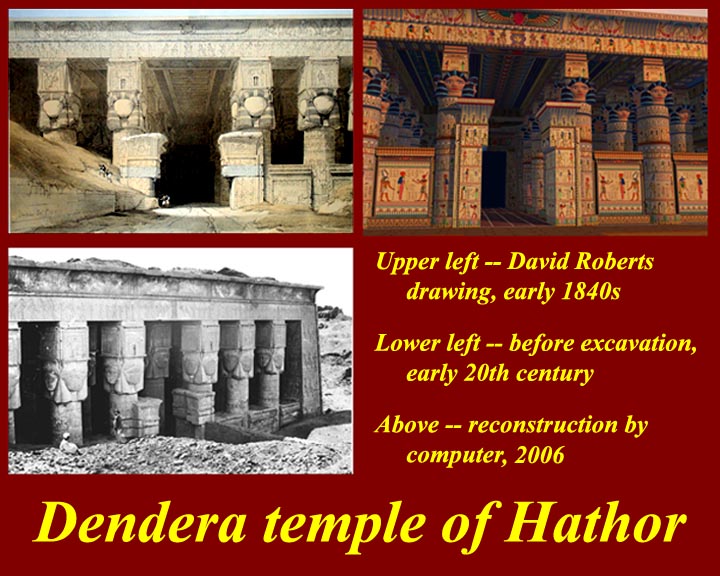
http://www.mmdtkw.org/EGtkw0442DenderaReconstruction.jpg
http://www.mmdtkw.org/EGtkw0445DenderaArialView.jpg
http://www.mmdtkw.org/EGtkw0444DenderaVari.jpg
The Roman-Egyptian hybrid temple at Dendera was dedicated to Het-Hert, whose name, in modern times, is usually written as Hathor. Even when written as Hathor, however, it's good to remember that the ancient Egyptians didn't have our combined "th" sound, so it should be pronounced Hat-hor with the T and the H separated. Hathor was the goddess of motherhood and childbirth, and this temple and others dedicated to her were really birthing centers with midwives presiding over maternity wards. Our jolly friend Bes would be ever present to keep the kids happy and content.
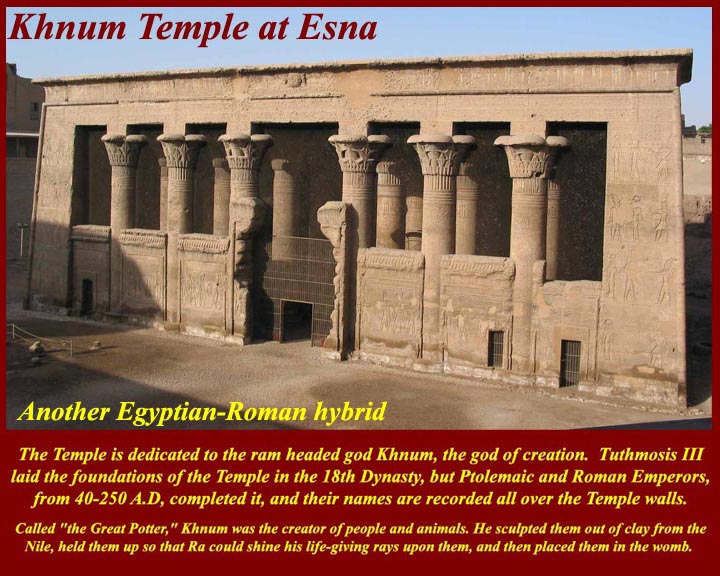
http://www.mmdtkw.org/EGtkw0446EsnaKhnumTemple.jpg
The Esna temple is dedicated to Khnum, and it is way off the tourist track. This image is here because it shows more clearly than the previous images the hybridization of the Roman and Egyptians architectural styles. This new front added to an older Egyptian temple is much akin to a Roman anticum (or Greek pronaos), an open vestibule before the cella in a classical temple, except that the space between the pillars is walled halfway up to allow space for Egyptian-style vignettes and hieroglyphs. The end slope inward slightly as do Egyptian pylons, and they are also decorated in the Egyptian manner.
Khnum, the ram headed god, was revered as "the great potter" who made all animals including humans. He would take Nile clay and make the form of an animal or human embryo, and then he would hold clay image up to the sky to be quickened by the rays of Ra before inserting it in the womb. This myth has led some to believe that the ancient Egyptians didn't know about the well known equation (sex = babies) but Egyptian medical texts make it clear that they knew it all -- and Khnum, like ram gods all around the Mediterranean, was also the god of fertility and joyous sex. Khnum, was the ancient Egyptian equivalent to the stork in stories told to children. For more about Khnum, see http://www.touregypt.net/featurestories/khnum.htm.
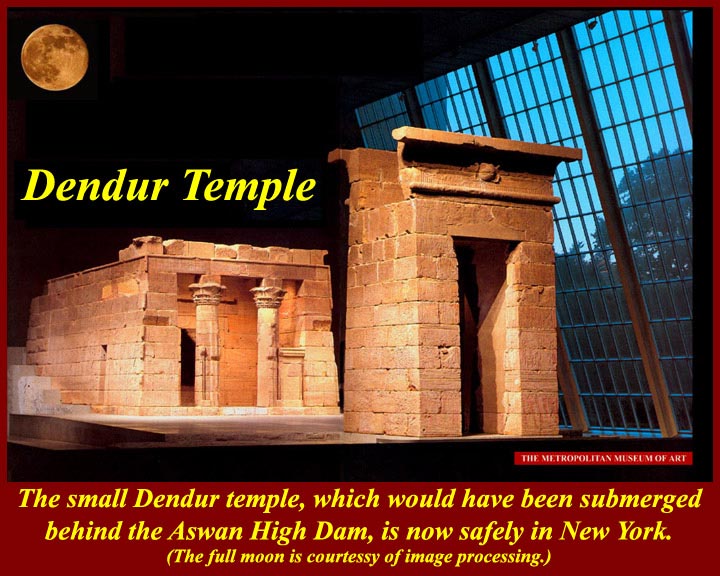
http://www.mmdtkw.org/EGtkw0442aDendurNYMet.jpg
Egypt too far to go to see an ancient Egyptian temple? Try the Metropolitan Museum in New York where the Dendur temple is dramatically displayed. It was saved from inundation behind the Aswan High Dam in 1976. It's a small Roman Period temple with a pillared front porch, but it's on a smaller scale than that of the Khnum temple, above. More details are available at http://www.metmuseum.org/Works_Of_Art/viewOne.asp?dep=10&viewMode=0&item=68.154
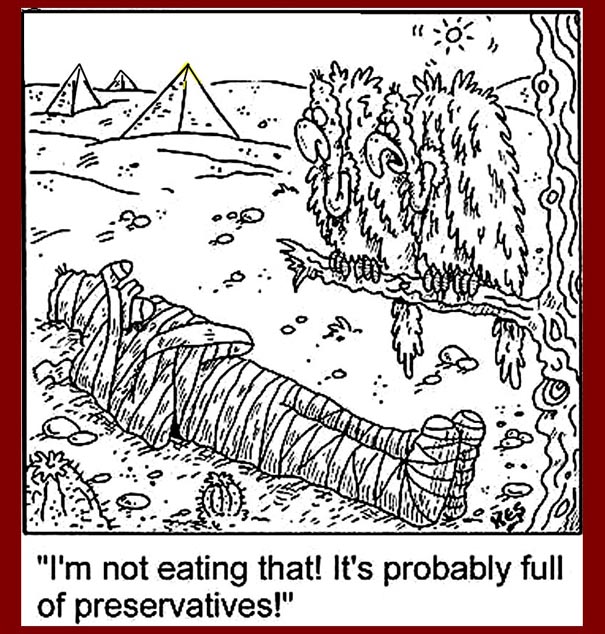
http://www.mmdtkw.org/EGtkw0447NotEatingThat.jpg
Mummification and preservation of the body was one of the most important tenets of Egyptian religion.


http://www.mmdtkw.org/EGtkw0448MummyMania.jpg
http://www.mmdtkw.org/EGtkw0449MummyComputerGame.jpg
Mummies, especially since the discovery of Tutankhamun's tomb in 1922, have also been a major preoccupation of Americans and Europeans.
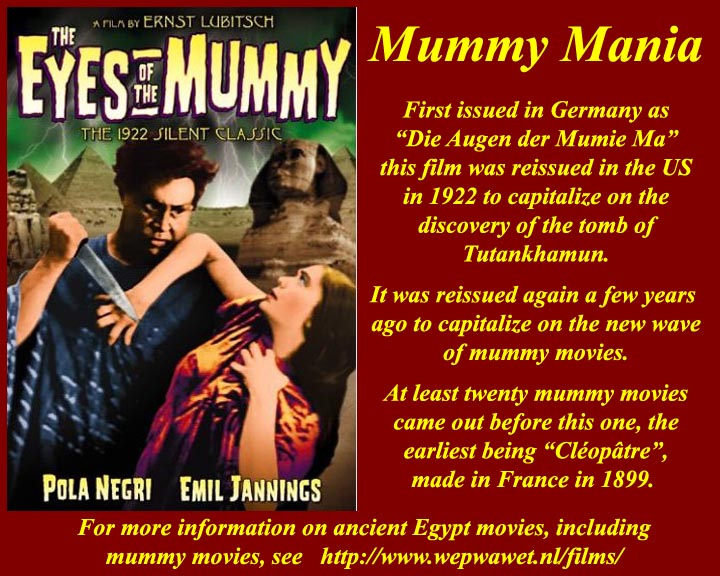


http://www.mmdtkw.org/EGtkw0450MummyEyes.jpg
http://www.mmdtkw.org/EGtkw0451ImhotepVaslooKarlov.jpg
http://www.mmdtkw.org/EGtkw0452MummyKarloff.jpg
Especially in movies, we have reveled in the horror of mummy attacks. The first known mummy movies was made in France in 1899 and was called Cléopâtre. In it a man with diabolical intent hacks Cleopatra's mummy to bits, then resurrects the woman from a smoking brazier. English title: "Cleopatra's Tomb". US-release title: "Robbing Cleopatra's Tomb". US mummy movies seem to run in cycles, the first following the release of the French 1899 flick and the last still going on. A seemingly exhaustive list of ancient Egypt themed movies, including mummy movies, is at http://www.wepwawet.nl/films/.



http://www.mmdtkw.org/EGtkw0453AbbottCostelloMummie.jpg
http://www.mmdtkw.org/EGtkw0454KidsMummies.jpg
http://www.mmdtkw.org/EGtkw0455HotMummies.jpg
There are mummy movies for all ages and tastes.
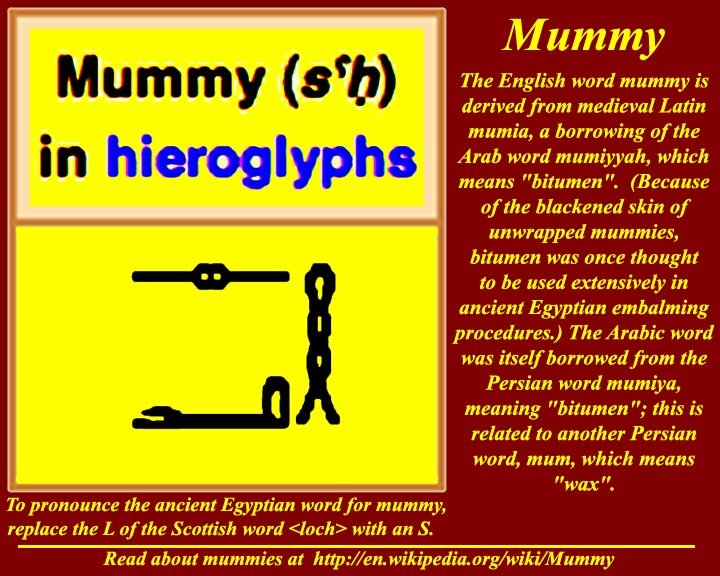
http://www.mmdtkw.org/EGtkw0456MummyEtymology.jpg
Egyptians, of course, didn't call the wrapped body a mummy. That word is from Arabic and Farsi (Persian). The ancient Egyptian word was something like "sox" only closer to the Scottish "loch" with an S replacing the L.
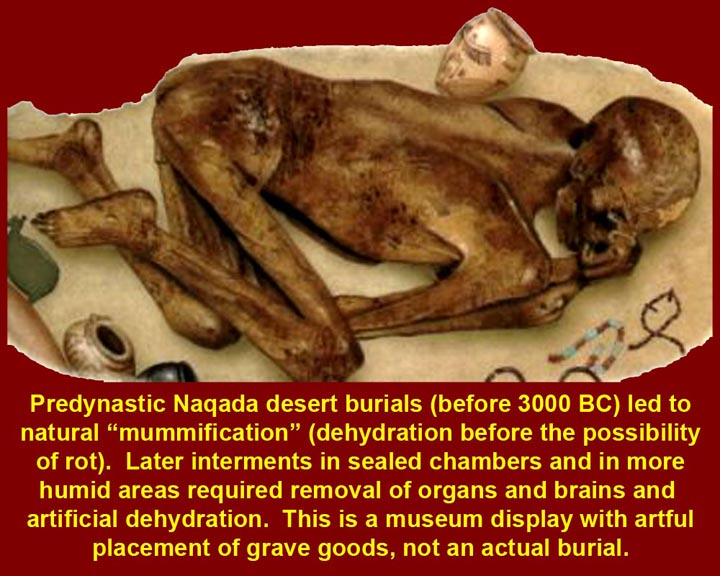
http://www.mmdtkw.org/EGtkw0457NaqadaGraveExhibit.jpg
It's generally acknowledged that the ancient Egyptians got the idea for artificial dehydration/mummification by observing the effects of burial in hot dessert sands. This dehydrated chap is known as "Ginger" for the color of his hair, and he is on permanent display in room 64 of the British Museum. The grave goods around him, all from the pre-dynastic Naqqada period as he is, are moved and changed occasionally, perhaps to keep him from being bored.
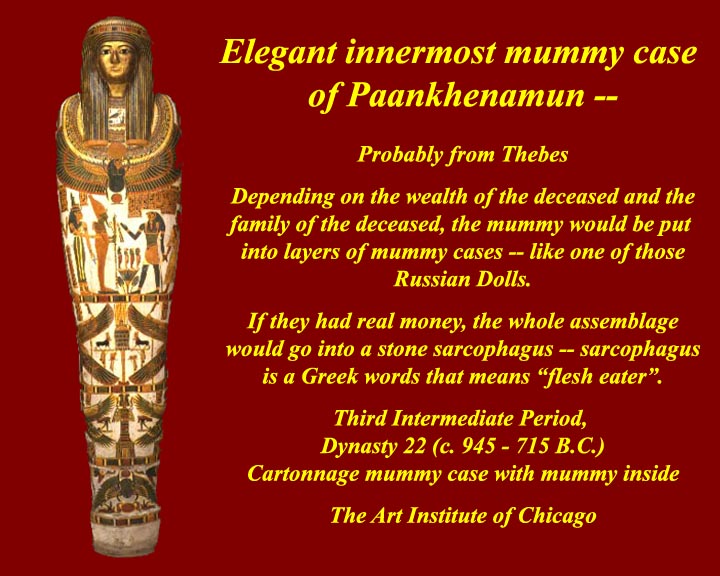
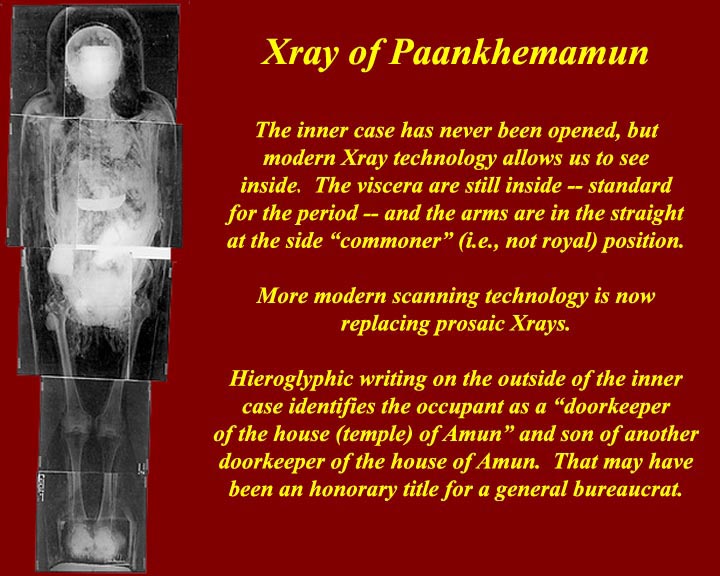
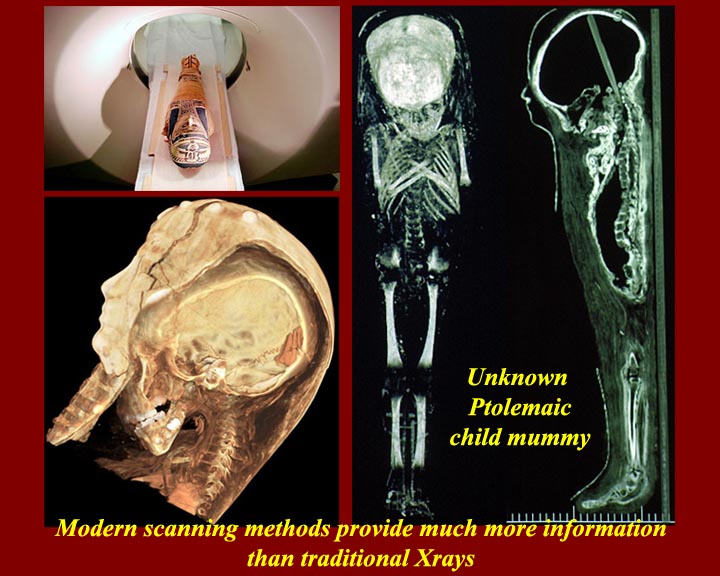
http://www.mmdtkw.org/EGtkw0458Paankhenamun1.jpg
http://www.mmdtkw.org/Egtkw0459APaankhenamunXray.jpg
http://www.mmdtkw.org/EGtkw0463PtolemaicChildScan.jpg
Unwrapping mummies for study (or for thrills, as they did in the "old days") is now passé. Plain old Xray examination is now also obsolete, and modern scanning methods are used instead. Queen Hatshepsut's mummy has finally been identified using modern Xray scanning methods. (See http://www.archaeology.org/online/features/hatshepsut/.)
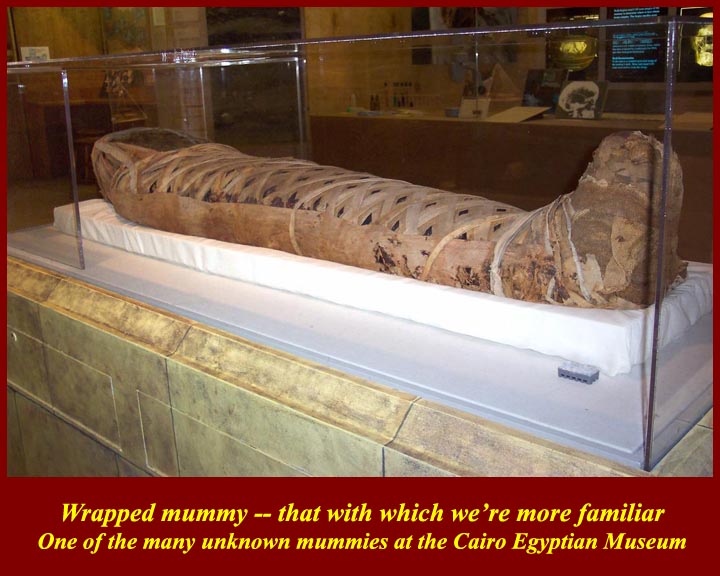
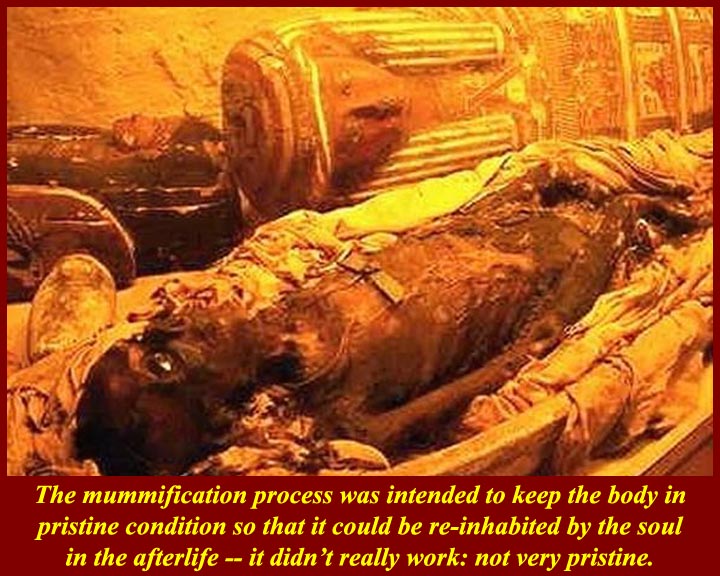
http://www.mmdtkw.org/EGtkw0460WrappedMummy.jpg
http://www.mmdtkw.org/EGtkw0461NotPristine.jpg
I'm not done with that! The purpose of mummifying the body of the deceased was that he still needed it in the afterlife. So you tried to keep his corpse in good condition. Claims that mummies are well preserved and lifelike and recognizable are balderdash. They are little better than bones with a bit of skin and sometimes with a hank of hair. Big news: it didn't work very well as preservation "for eternity".
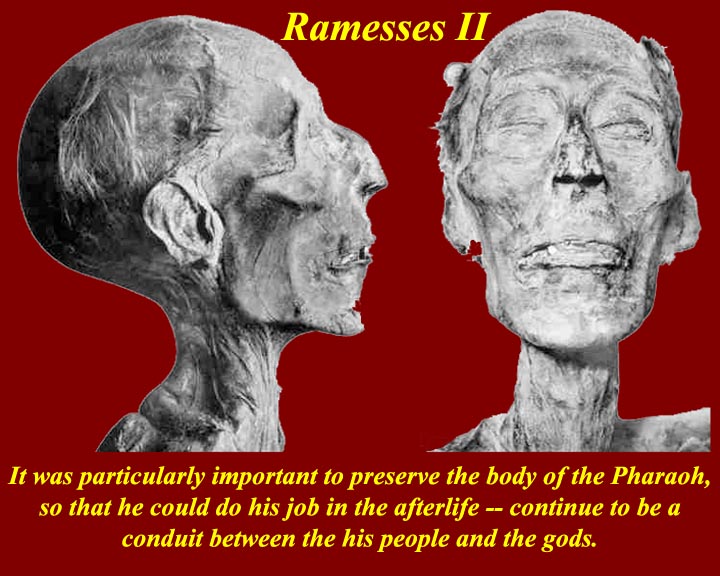
http://www.mmdtkw.org/EGtkw0462RamessesIIMummy.jpg
Even those at the top of the heap -- those who got the best that ancient Egyptian mortuary science had to offer -- don't have much to work with in the extended afterlife. Here is Ramesses II looking more and more like an aging Peter O'toole (http://www.thecinemasource.com/moviesdb/images/Venus%20-%20Poster.jpg).
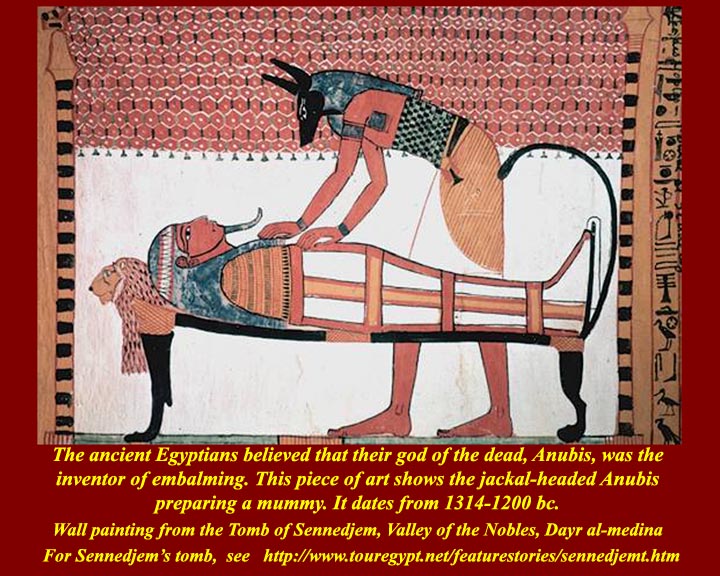
http://www.mmdtkw.org/EGtkw0464AnubisEmbalming.jpg
Anubis was the inventor of the mummification and embalming process, according to ancient Egyptian mythology.
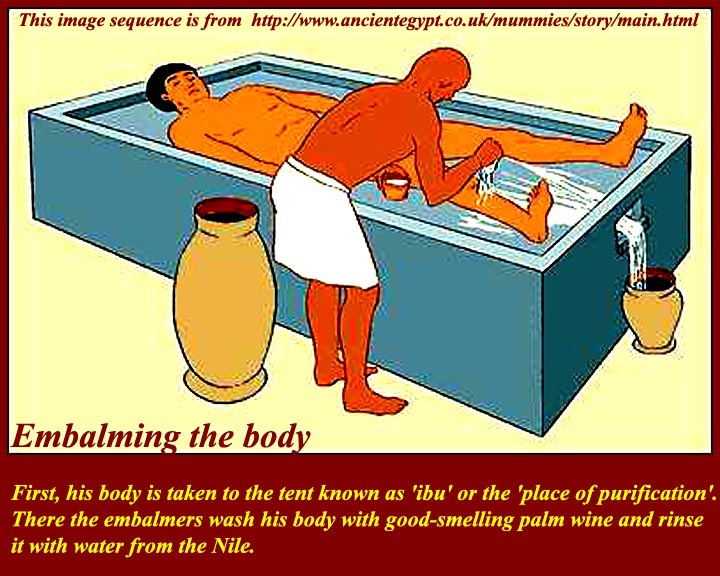
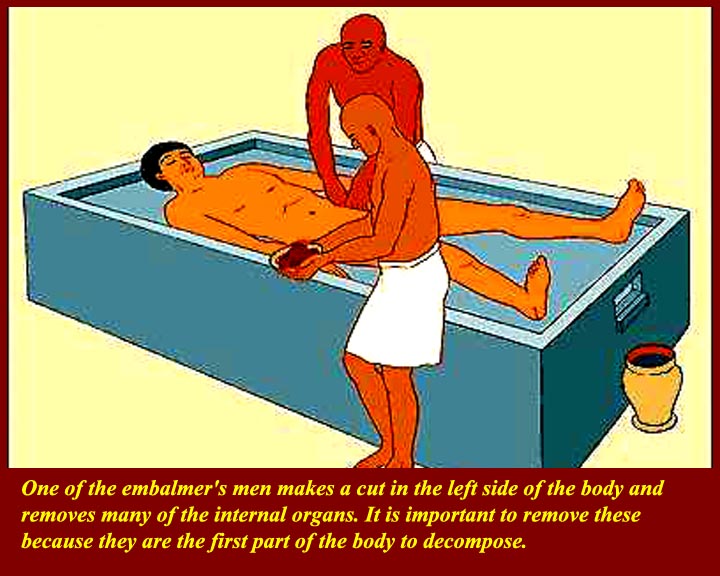
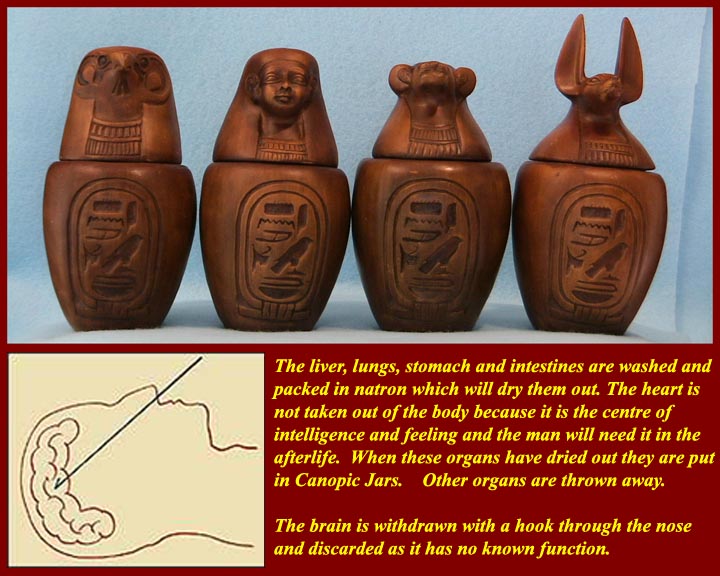
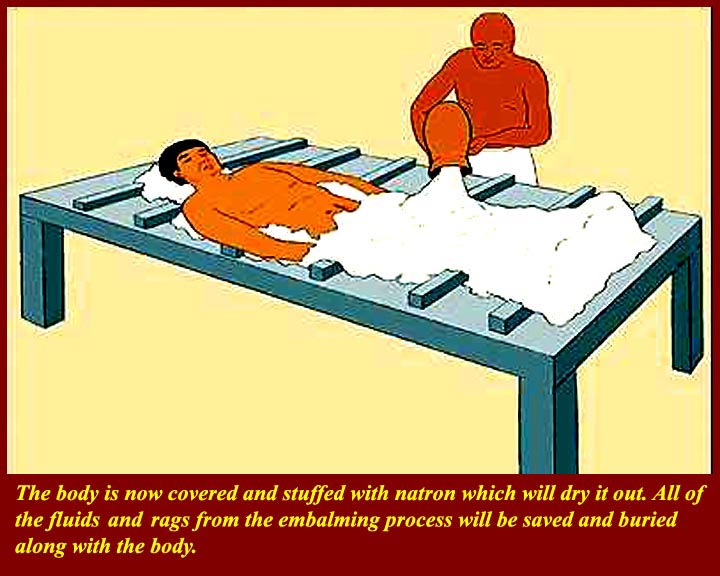
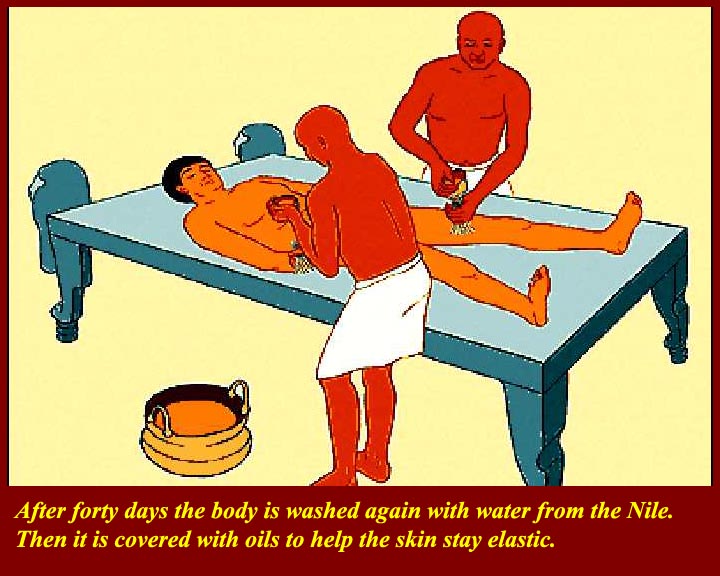
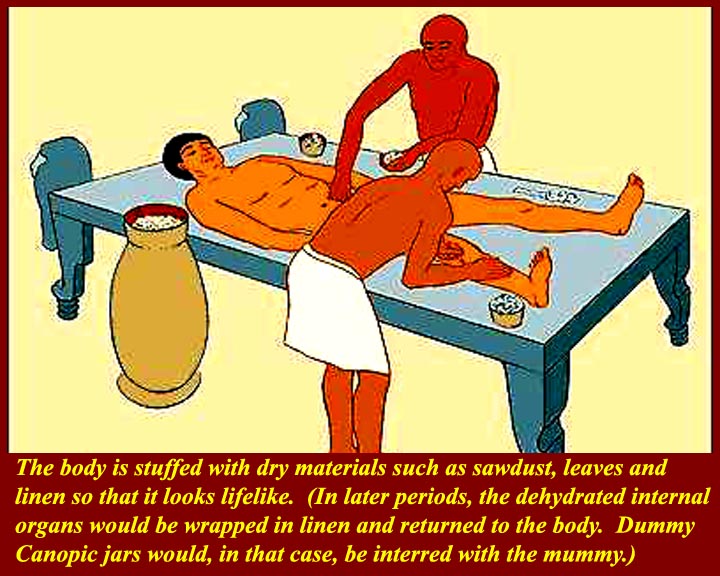
Embalming: British Museum
http://www.mmdtkw.org/EGtkw0465Embalming1.jpg
http://www.mmdtkw.org/EGtkw0466Embalming2.jpg
http://www.mmdtkw.org/EGtkw0467Embalming3.jpg
http://www.mmdtkw.org/EGtkw0467Embalming4.jpg
http://www.mmdtkw.org/EGtkw0469Embalming5.jpg
http://www.mmdtkw.org/EGtkw0470Embalming6.jpg
See more at the British Museum site: http://www.ancientegypt.co.uk/mummies/home.html
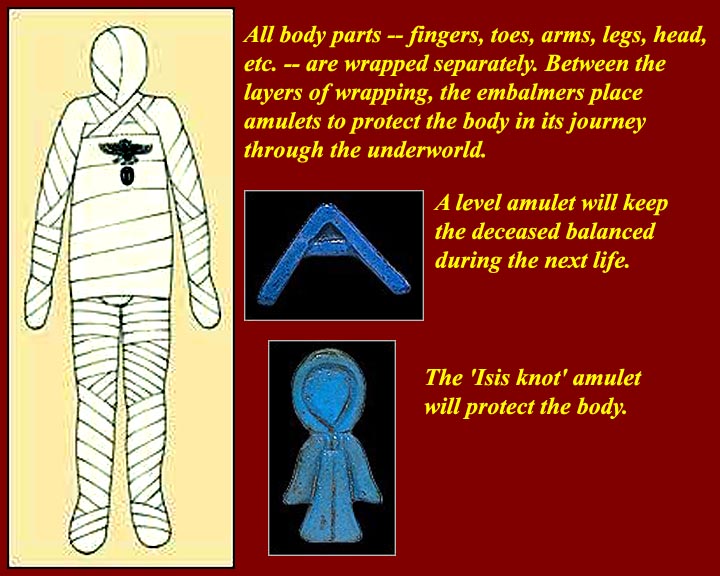
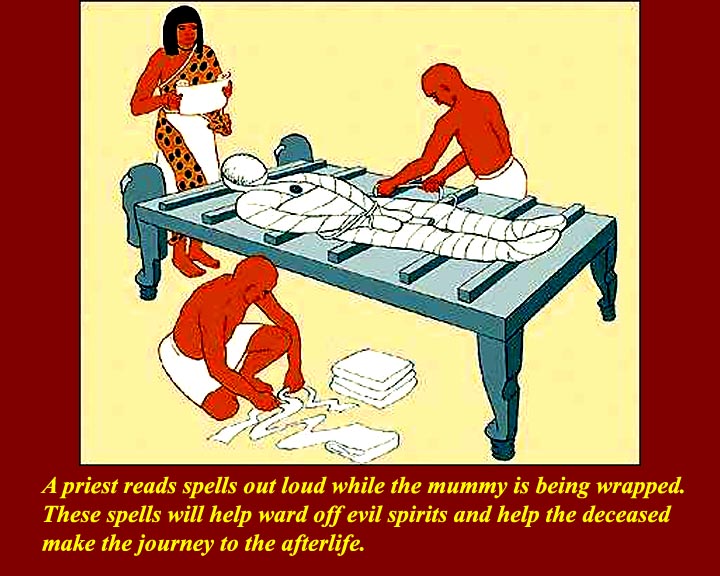
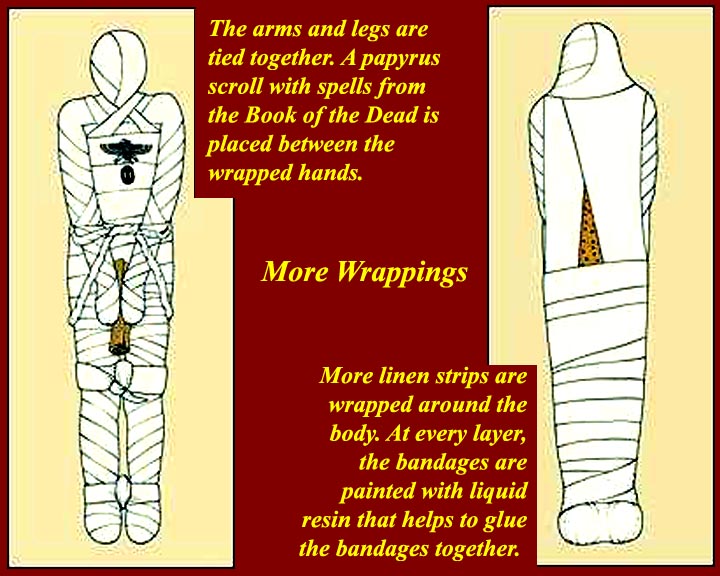
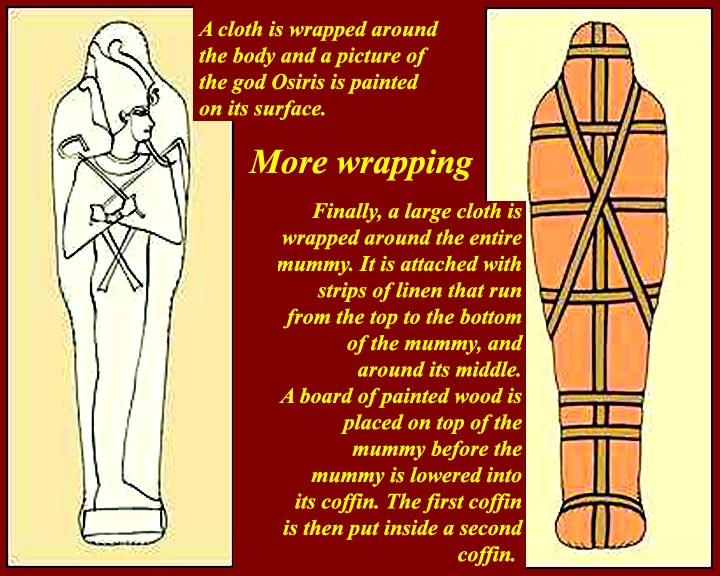
Wrapping: British Museum
http://www.mmdtkw.org/EGtkw0471Wrap1.jpg
http://www.mmdtkw.org/EGtkw0472Wrap2.jpg
http://www.mmdtkw.org/EGtkw0473Wrap3.jpg
http://www.mmdtkw.org/EGtkw0474Wrap4.jpg
See more at the British Museum site: http://www.ancientegypt.co.uk/mummies/home.html
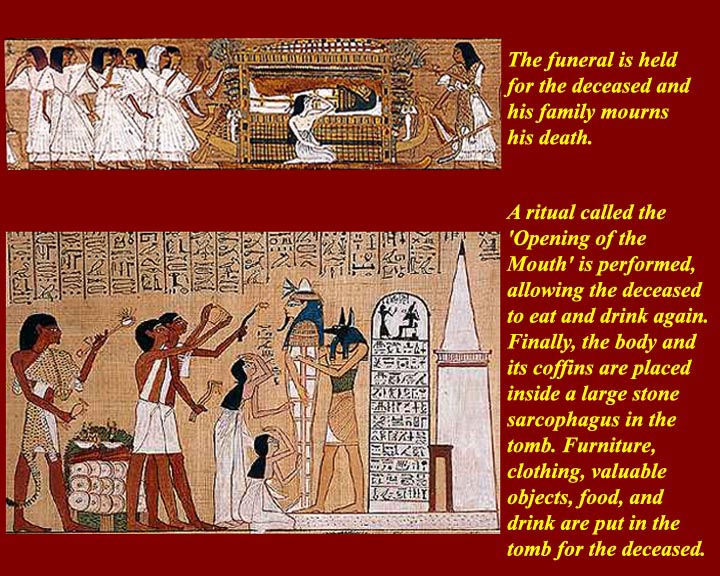
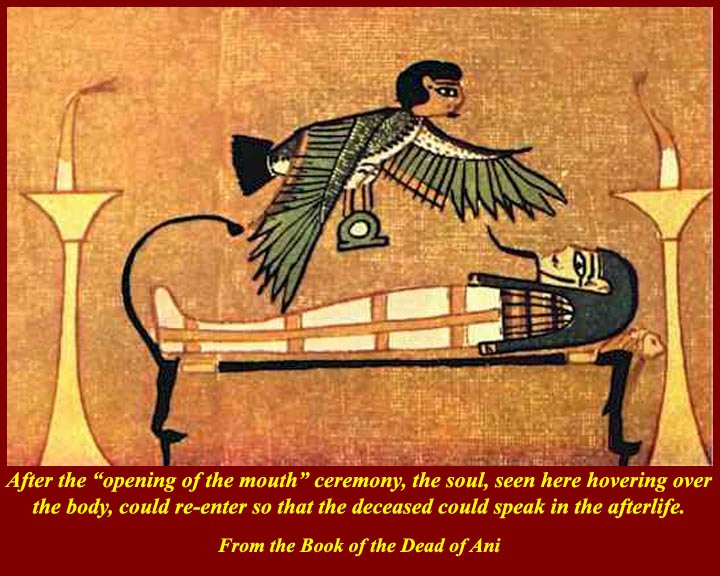
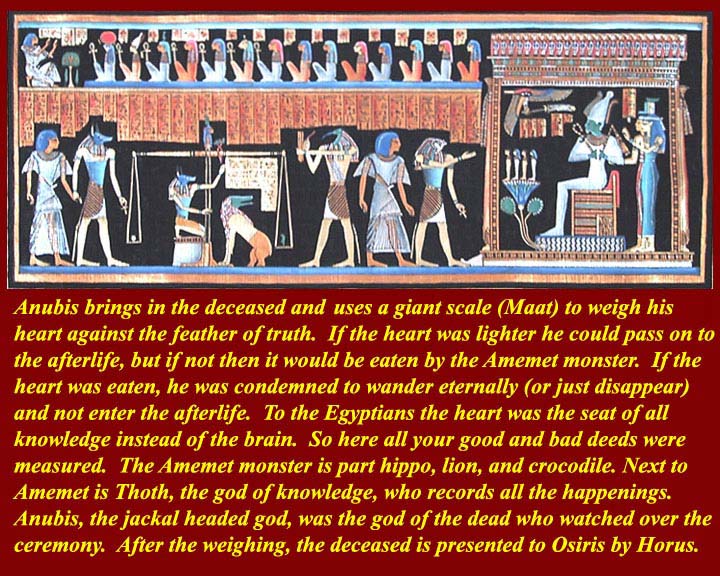
http://www.mmdtkw.org/EGtkw0475Mourn.jpg
http://www.mmdtkw.org/EGtkw0476SoulHovering.jpg
http://www.mmdtkw.org/EGtkw0476Weighing_of_heart.jpg
The family mourns privately and then a priest uses a special ceremonial knife in a rite called the "opening of the mouth", which allows the deceased to eat, drink, and speak in the afterlife. The latter is of most immediate importance because he will have to speak protective spells to get through the judgment. In the last image, his heart is weighed against the"feather of truth" on a big scale called Maat (also the name of the goddess of judgment). If his heart is heavy, he fails and is eaten by the monster Amemet. If he passes, Horus presents him to Osiris, the head of the afterlife pantheon. Osiris became the god of the dead because he was murdered and chopped up and thrown into the Nile by his brother Set. Isis reassembles him and bandages him -- the supposed origin of mummy wrapping. Osiris is always shown bandaged (mummy wrapped) and his skin is green, signifying faunal rebirth and floral fecundity. Set is the evil god of the desert and its hot dessicating wind and therefore the anti-green enemy of agriculture and herding. There's more about the Osiris-Isis-Set legend at http://www.philae.nu/philae/IsisOsiris.html
and at http://touregypt.net/godsofegypt/legendofosiris.htm.
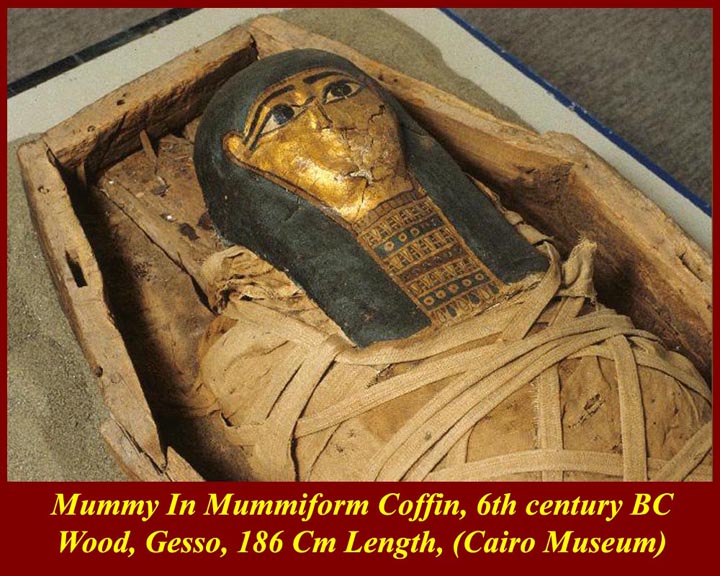
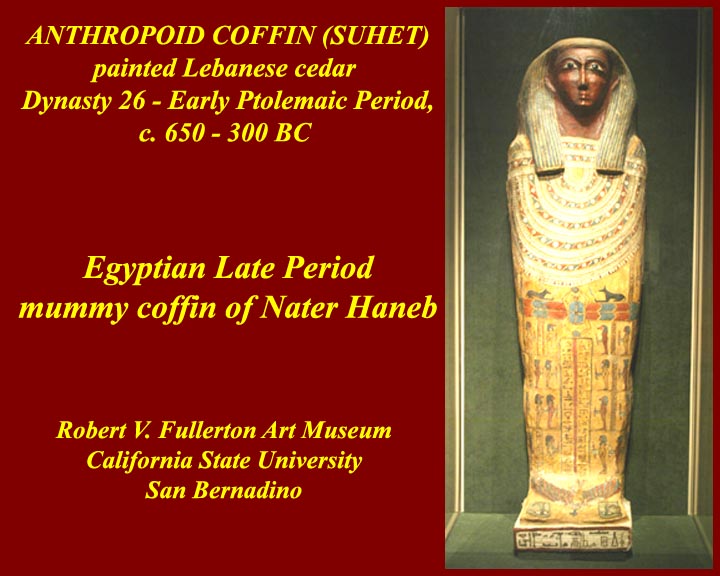
http://www.mmdtkw.org/EGtkw0477ThirdIntermediateMummy.jpg
http://www.mmdtkw.org/EGtkw0478PtolemaicMummyCofin.jpg
Even in later periods, the mummification rituals were observed. These are an Third Intermediate Period Mummy and a Ptolemaic mummy.
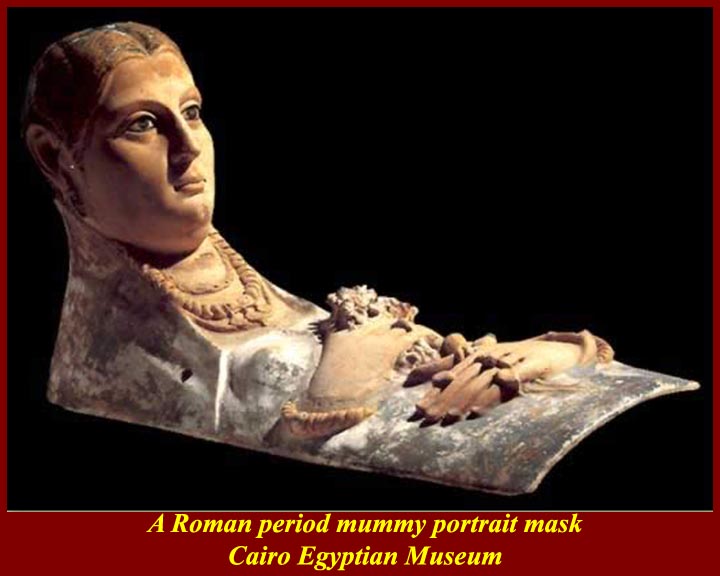
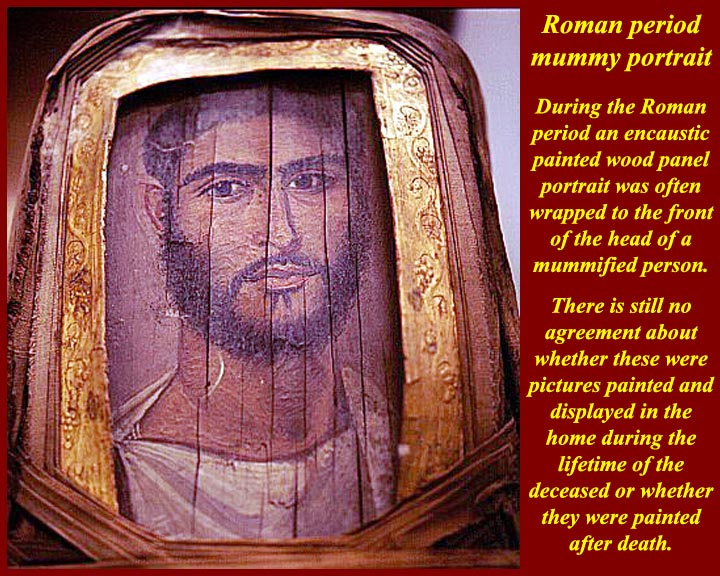
http://www.mmdtkw.org/EGtkw0479RomanMummyPortraitmask.jpg
http://www.mmdtkw.org/EGtkw0480RomanMummyPaintePortrait.jpg
In the Roman period, several different mummy styles developed. The first image shows a mummy mask in the rising style that the Romans had inherited from the Etruscans. Masks like there are portrait masks (i.e., they showed what the person really looked like rather than idealized imagery). This one, however, is shown with conventional Ptolemaic pursed lips. Both men and women would go about with the lips puckered because it was said that the Ptolemies had beautiful narrow Cupid's bow lips. She may have really looked like this, but maybe the artist did her a favor. The second image is the much more common wax encaustic portrait on a flat wooden board that was commonly wrapped into the last layer over the face of the deceased. There is much debate about whether these portraits were painted when the person was still alive (and displayed as wall paintings in the home) or whether they were painted after death specifically for the mummy wrap. Which ever is true, the arresting characteristic of all of these paintings is the eyes that pierce your soul.
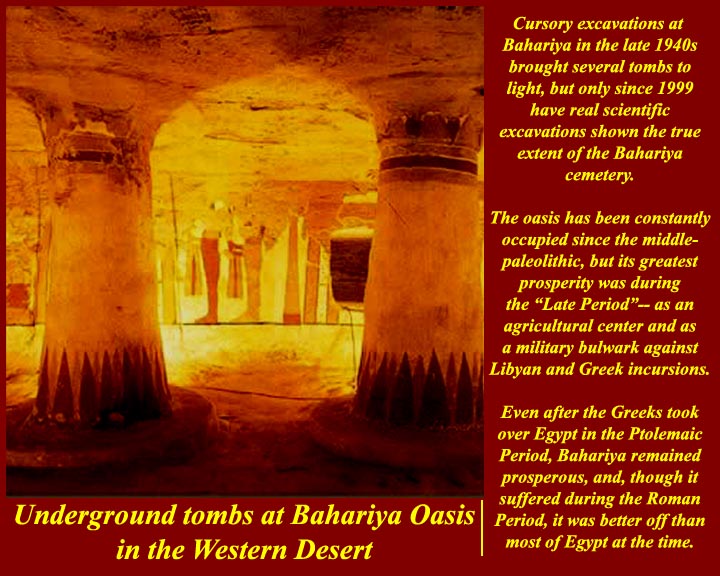
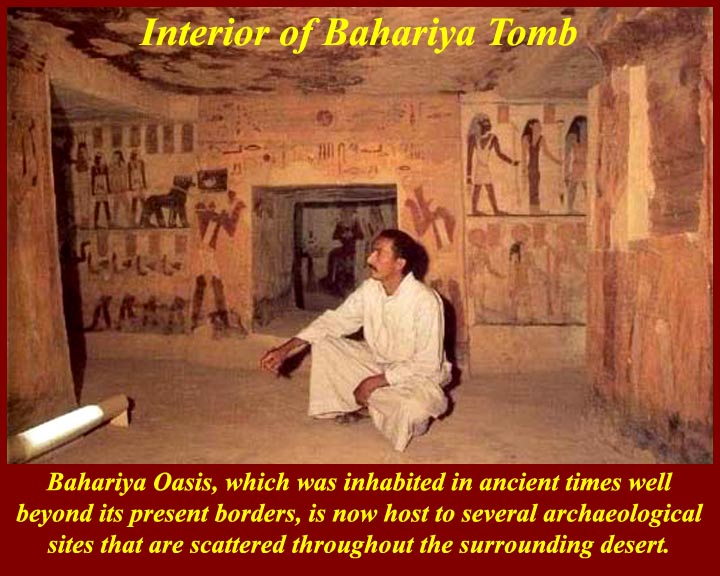
http://www.mmdtkw.org/EGtkw0481BahariyaTomb1.jpg
http://www.mmdtkw.org/EGtkw0482BahariyaTomb2.jpg
The Bahariya Oasis in the Western Desert has apparently been continuously inhabited since the Egyptian Middle Paleolithic period and excavated burials and tombs in the area span the whole time from pre-dynastic Egypt through the 18th century AD. There are, in fact, more recent tombs and burials, but nobody has dug them up. The most important period from an archaeological perspective runs from the Ptolemaic period through the Coptic and Byzantine early-Christian period. The Bahariya cemeteries have been undergoing scientific excavation (as opposed to tomb robbing excavations) since 1996, and more recently, Egyptian archaeologists have uncovered the "Valley of the Golden Mummies". Egyptian archeological authorities kept the site secret until they could secure the area and start their own excavations in 1999.
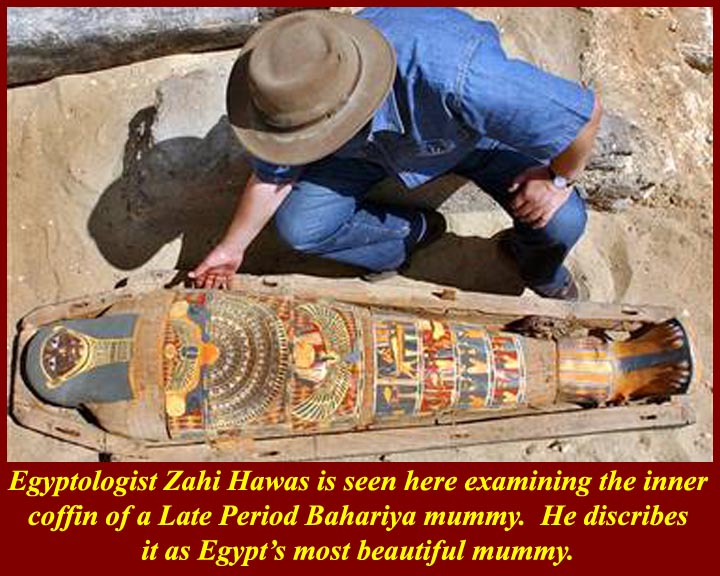
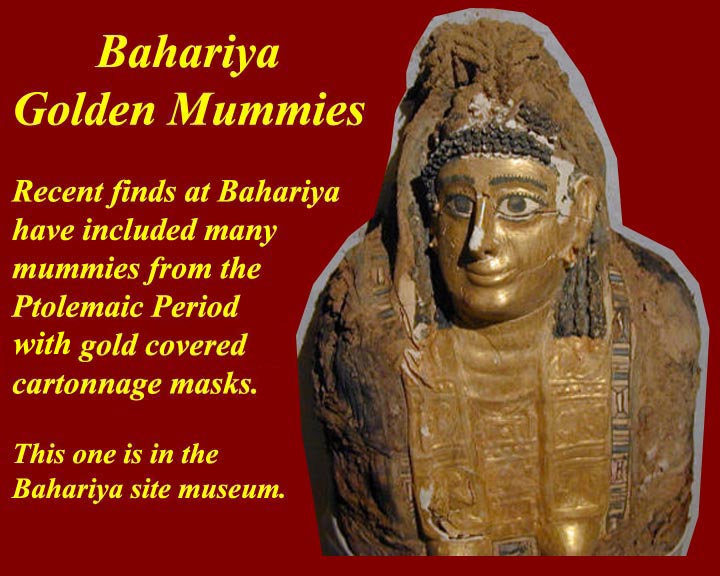
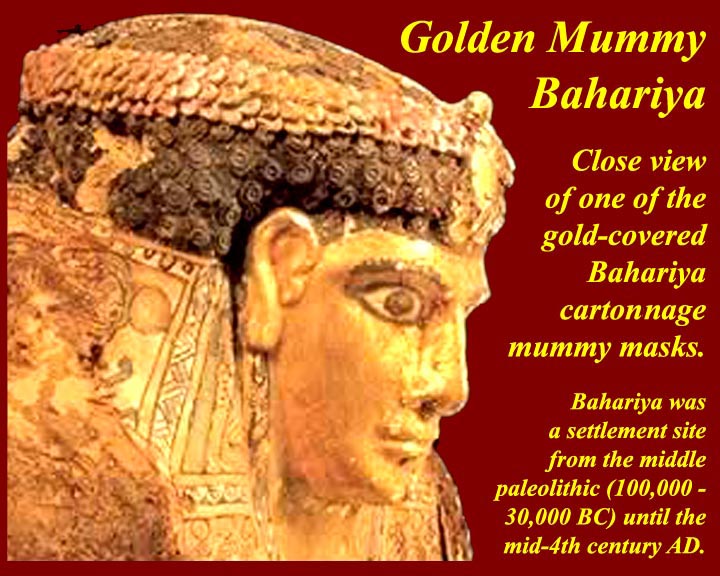
http://www.mmdtkw.org/EGtkw0483BahariyaBeautifulMummy.jpg
http://www.mmdtkw.org/EGtkw0484BahariyaGoldenMummy1.jpg
http://www.mmdtkw.org/EGtkw0485BahariyaGoldenMummy2.jpg
For articles Zahi Hawass, Secretary General of the Supreme Council of Antiquities (SCA) about the Bahariya site, go to http://guardians.net/hawass/mummy-main.htm.
The recent videos by National Geographic and the History Channel on this and other Egyptian mummy hunts are extremely disappointing. They have about ten minutes of information, which they stretch to an hour or two with useless chatter and dramatic night time footage -- mostly of the "reporter on the scene" (and in the way) type that we are familiar with from the evening (non-)news: "I'm standing outside the tomb....", then "I'm going through the passageway to....", then "I'm in the tomb with Zahi....", then "Zahi says this will be important because...", then "Although we didn't find what we expected, it's still important because....". Then Zahi talks about how everything, even if it's not a major find, is "still very important". Then there is an advertisement for the next mummy hunt or mummy CAT scan. There are interspersed, of course, many commercial breaks preceded by breathless dramatic pauses. It's pretty pitiful stuff compared to watching the news on the BBC which can cover the same event in a two minute spot. If price is a measure of quality, it's illustrative that the the National Geographic DVDs can be bought new from Internet for about four dollars. That's a heavy discount from the $25 that they sell for at the National Geographic Internet site.

http://www.mmdtkw.org/EGtkw0486ThatsAWrap.jpg
